HERBALS.
(1484 ff. – )
See also: Arbolayre (or Grant Herbier).
In a descriptive bibliography of mineralogy, it would seem that the merits of the early herbals would seem limited, but the facts are quite different. As a group, this type of book records the late medieval view of the natural world in terms of how nature could be used to benefit man. Relationships and the uses of plants, animals and minerals discussed in these texts offers insight into the early development of medicine, agriculture and pharmaceutical therapies for the common person. In short, the herbals retain their relevancy to early mineral studies.
The early printed herbals are among the most remarkable of the stream of books printed in the incunabula period because they are milestones in the history of printing and scientific illustration. Although the name implies a strictly botanical treatise, this class of book refers to a practical medical text intended for both physicians and the common folk. It appeared in reaction against the expensive apothecary, calling attention to a wide range of easily available natural remedies derived from plants, animals and minerals. In their time, these volumes were a very popular technical literature, and regularly relied upon by their readers to provide cures for various ailments. However, because of this career, many copies of these volumes were destroyed, and the long history of the survivors is reflected in their usually sad condition.
The beauty, rarity and inaccessibility of the herbals has both spurred and stymied bibliographical research, and caused much in the way of publication. As a result errors in the literature have been introduced or permitted to stand. Besides elucidating the mineralogical content of these books, the purpose of this study is to hopefully unravel the bibliographical knot of the herbals.
Most of the information related to the herbals has occurred due to bibliographical scholarship in botany. However, a perplexing problem in this field is the confusion over the various titles by which the early herbals are known. For the current study, the system proposed by Arnold Klebs in his description of the Becher collection is used. Klebs assigns priority to the 1484 printing by Schoeffer of the Herbarius, which contains 150 illustrated chapters. All subsequent appearances of this work will incorporate as a compiler's comment the word Herbarius at the beginning of the title. Schoeffer's second herbal comprising 435 chapters, was published at Mainz in 1485 and was termed Der Gart by Klebs but in this study is referred to as Gart. This designation will appear at the beginning of each appropriate title. The final member of the herbal triad consists of 1,066 chapters and is referred to by the descriptor Hortus. In the past, these three distinct families have been bibliographically confused, with some researchers stating that they are translations of each other, which is not possible. By relying on the number of chapters within the text, 150, 435 and 1,066 respectively, it is possible to untangle the bibliographies of the Herbarius, Gart and Hortus.
Biographical references: Arber, Herbals, their Origin and Evolution, 1986. • Bessler, Das deutsche Hortus-Manuskript des Henricus Breyell, 1952. • Dann, G.E., "Kräuterbuch von der Antike bis zum Ende des Mittelalters. Eine Übersicht", Math. med. Normark, 26, (1974), 375-91, illus. • Gaebler, 2000 Jahre Kräuterbücher, 1964. • Gilson, Herbals in the Fry Collection, 1973. • Heilmann, Kräuterbücher, 1966. • Schmid, Ueber alter Kräuterbücher, 1939. • Singer, C., "The Herbal in Antiquity and its Transition to Later Agers", Journal of Hellenic Studies, 47, (1927), 1-25. • Stannard, Medieval Herbals and their Development, 1974. • Stannard, The Herbal as a Medical Document, 1969.
Herbarius Latinus
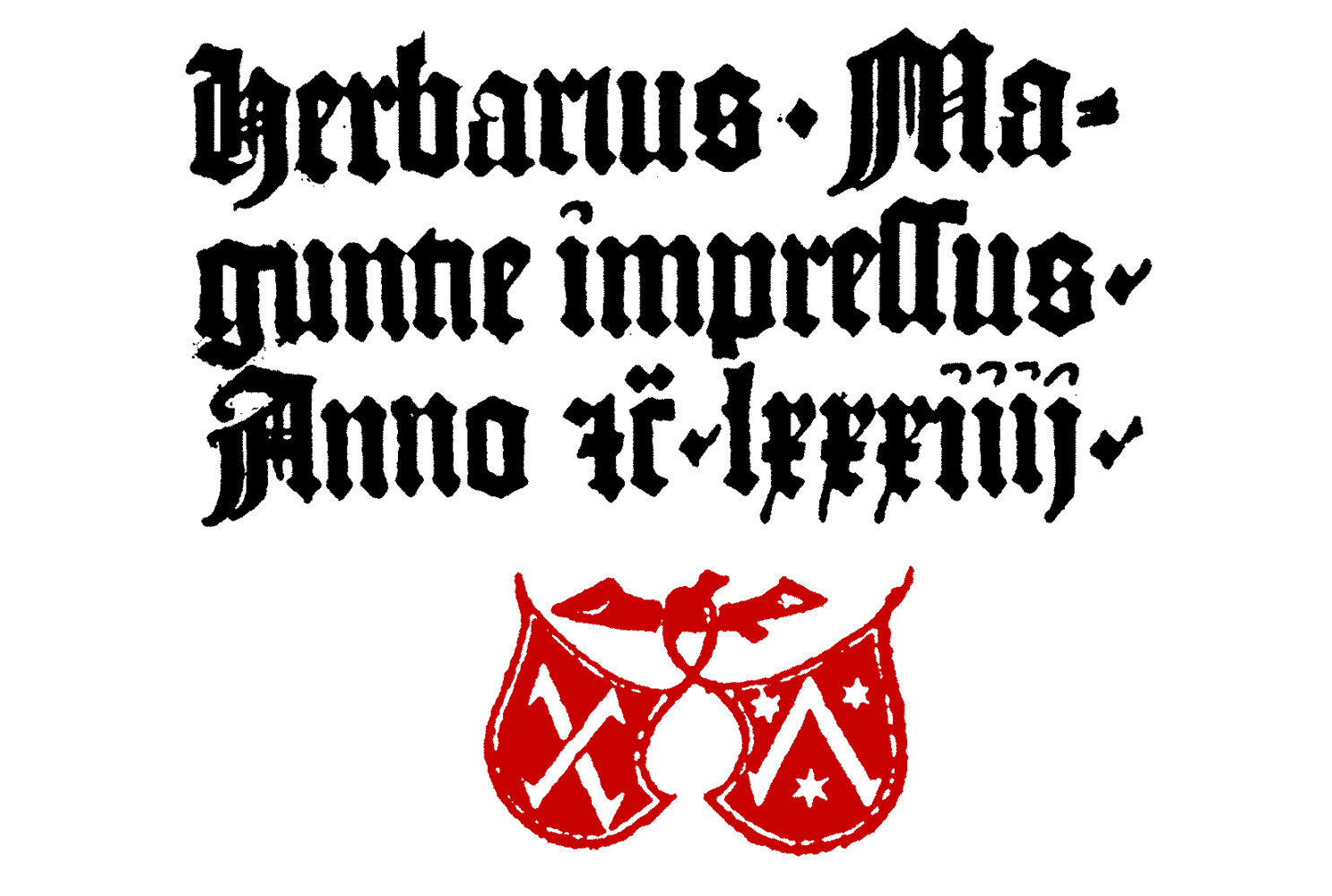
1. Latin, 1484 [First edition].
[Herbarius]
[In black:] Herbarius. Ma= | guntie impressus. | Anno &c.lxxxiiij. | [in red, printer's mark].
4°: [14 2-218 2210] (unsigned; 19/8 blank); 174l.; no pagination, foliation or signiature marks. 150 woodcuts of plants in the text numbered i-cl. Capital spaces. Page size: 210 x 145 mm.
Contents: 1/1r (=1r), Title.; 1/1v (=1v), Blank.; 1/2r-1/2v (=2r-2v), Preface, beginning: "[R6]Ogatu plurimo[old aux] inopū nūmo[old aux] | egentiū appotecas refutātiū oc= | casioni illa {\cp} necessaria ibidē ad | corp9 egrū spectātia sūt cara sim | plicia et composita. nūmisqz pluri | mis [Con]parāda ..."; 1/3r-1/4v (=3r-4v), Index, "Capitula herbarū sc[old aux]'m | ordinem alphabeti.".; 2/1r-19/6v (=5r-154v), Text describing 150 herbs arranged alphabetically in 150 chapters on 150 leaves.; 19/7r-22/10r (=155r-174r), Text of remaining six parts of the book.; 22/10v (=174v), line 22, End: "... Valet etiā ut inde fiant | suppositoria desuP spergantur pulueres de esula | et puocabūt asellationem."
Edition princeps. Very rare. This is the first herbal printed in Germany, from the shop of Peter Schoeffer [see note below], one of the first printers, which issued from his press at Mainz in 1484. Herbals were so called because they described medical remedies derived chiefly, but not solely, from herbs and plants, which were then the major source of medicines. As is shown by it rapid transmission through original and pirated editions, Schoeffer's Herbarius rapidly became one of the most popular and useful handbooks for the general public and medical communities. The woodcut illustrations of plants helped to sustain it popularity, and these pictures were copied and recopied in subsequent editions.
The Herbarius shows every sign of being a compilation rather than an original work, for it quotes material drawn from classical, Arabic, and medieval sources, none of which appeared later than a century before the Herbarius was printed. No manuscript of it has been discovered as yet, and the original source of its illustrations remains unidentified. However, the plant species described are all found in central-northern Europe, which perhaps points to a Germanic source of the text. Schoeffer probably discovered an older manuscript which he commited to the press.
The text of the book is divided into seven parts: (1) De virtutibus herbarum, which is the major portion describes 150 German herbs and plants in brief chapters, each illustrated by a woodcut, (2) De simplicibus laxativis et lenitivis, provides information on 12 simple laxatives, (3) De simplicibus comfortativis, describes in 16 chapters various spices, (4) De fructibus et seminibus et radicibus, 22 chapters on fruits and nuts (5) De gummis et eis similibus, 10 chapters on gums, (6) De generibus salis et mineris et lapidibus, 16 chapters on minerals, stones and salts, including alum, silver, coral, lapis lazuli, sulphur, tartar, and (7) De animalibus et provenientibus ab eis, in 20 capters describes pharmacological products derived from various animals.
The first edition of the Herbarius exists in several variations, none of which constitutes a separate edition, but rather each reflects a condition that occurred during the printing of the book. For convenience they are listed as A1, A2, A3, B1, B2, and B3. A1 has the title on its first leaf, printed in red or black, and also bears the date of 1484 and Schoeffer's device. A2 transposes the woodcuts for chapters 42 and 48 (Cuscuta and Cannabis), and misnumbers chapter 75 as 73. A3 corrects the misnumbering but allows the exchanged illustrations to remain uncorrected. B1 has its first leaf blank (i.e., no title page), B2 places the woodcuts for chapters 42 and 48 in their proper positions, but misnumbers 75 as 73, and B3 corrects the misnumbering, but retains the transposed illustrations in chapters 42 and 48.
Johann von Cube. (Born: ; Died: Franckfurt am Main, Germany, Between 23 September and 5 March 1503/4) German physician. Cube (also known as, Johann Dronnecke (or Wonnecke) von Caub or Cuba) lived at the end of the 15th century in Augsburg. He was physician to Adolf III of Nassau and Adalberts of Saxony. In 1484, he relocated to Frankfurt am Main where he was appointed the city physician. For centuries, he was considered the author behind the Herbarius (1484), but more recent research shows that he was at most an editor.
Peter Schoeffer. (Born: ; Died: ) German printer. Schoeffer started as a calligrapher in Paris before coming to Mainz where he served as foreman in Guttenburg's shop. After Johann Fust repossessed Gutenburg's equipment in 1455/56 he employed Schoeffer to do the printing as well as produce type for it. Later, Schoeffer married Fust's daughter and ultimately inherited the business.
Bibliographical references: BMC XV: 1, 39 [IA 288-89]. • Brunet: 3, 106. • Choulant, Graphische Incunabeln, 1858: p. 13, no. 1. • Cleveland Herbal & Botanical Collections, 1992: no. 6. • Fairfax Murray (German): 1, 327-8, no. 190. • Goff: H-62. • Goff: no. H-62. • Goff: no. H-62. • Goff: no. H-62. • Goff: no. H-62. • Goff: no. H-62. • Hain, Repertorium Bibliographicum, 1826-38: no. 8444. • Hain, Repertorium Bibliographicum, 1826-38: no. 8443?. • IGI: no. 4671. • IGI: no. 4675. • Klebs, Incunabula Scientifica, 1938: no. H-62. • Klebs, Incunabula Scientifica, 1938: no. 506.1. • Klebs, Herbals of the Fifteenth Century, 1917-8: p. 89, no. a. • Klebs, Catalogue of Early Herbals, 1925: no. 2. • Klebs, Catalogue of Early Herbals, 1925: no. 1. • Klebs, Catalogue of Early Herbals, 1925: no. 2. • Klebs, Catalogue of Early Herbals, 1925: no. 3. • Nissen (BBI): no. 2299. • NUC: 241, 470-1 [NH 0295031]. • Oates, Cambridge 15th Century Books, 1954: no. 35. • Payne, `Herbarius' and `Hortus Sanitatis', 1901: pp. 72-8. • Pellechet, Catalogue General des Incunables, 1970: no. 1311. • Polain, Catalogue, 1932: no. 1878. • Pritzel, Thesaurus Literaturæ Botanicæ, 1871-3: no. 10753. • Proctor, Index, 1898-1906: no. 121. • Proctor, Index, 1898-1906: no. 142. • Schramm, Bilderschmuck der Frühdrucke, 1922-36: 14, p. 9. • Schreiber, Kräuterbücher, 1924: p. iv-vi. • Schreiber, Manuel de la Gravure, 1893-1911: no. 4203. • Schreiber, Manuel de la Gravure, 1893-1911: no. 4204. • Schreiber, Manuel de la Gravure, 1893-1911: no. 4205. • Sudhoff, Deutsche Medizinische Inkunabeln, 1908: no. 83a. • Sudhoff, Deutsche Medizinische Inkunabeln, 1908: no. 83a. (Cube) ADB: 4, 637. • Archiv für Frankfurts Geschichte und Kunst: 7, 110ff. • Archiv für Geshichte des Buchwesens:: Jg. 58, 1129-36. • DBE: 2, 408 [see, Cuba, Johannes von]. • Hirsch, Biographisches Lexikon, 1884-8: 2, 151 [by W. Stricker]. • Nissen, Herbals of Five Centuries, 1958: 56. • Pritzel, G.A., "Johannes von Cube," Botanische Zeitung, 4 (1846), 785-90. • Stammler, Deutsche Literatur des Mittelalters, 1933-55: 4, col. 1093 [by K. Sudhoff]. • Stricker, W., "Ueber Johann von Cube, Stadtarzt zu Frankfurt am Main und Verfasser des `Ortus Sanitatis' zum Theil nach den Aufzeichnungen von Georg Kloss," Henschel's Janus, 1 (1846), 779-86. [Reprinted: Leipzig, Alfred Lorentz, 1931]. (Schoeffer) BMC XV. • Geldner, Die deutschen Inkunabeldrucker, 1968-70. • Heilmann, Kräuterbücher, 1966: 387-7, portrait. • Lexikon des Buchwesens. • Ruppel, A., Peter Schoeffer aus Gernsheim, Mainz/Berlin: Gutenberg-Gesellschaft, 1937, 62, [2] p., frontispiece, 9 facsimiles. • Wehmer, Deutsche Buchdrucker, 1971.
2. Latin, 1484.
[Herbarius]
Herbarius (with German synonyms) ... Speyer, Johann and Conrad Hist, 1484.
4°: [14 2-228] (unsigned; 22/8 blank); 172l.; no pagination, foliation or signiature marks.
Contents: 1/1r, Title (=1r), "Herbarius."; 1/1v (=1v), Blank.; 1/2r-1/2v, "[R]Ogatu plurimorum inopum num | ..."; 1/3r-1/4r (=3r-4r), "Capitula herbarum secundum | ordinem alphabeti, ..."; 1/4v (=4v), Blank.; 2/1r-19/6v (=5r-154v), Text of herbs with the woodcuts.; 19/7r-19/7v (=155r-155v), "Particula secunda de | simplicibus laxaliuis | liniliuis seu lubrica- | liuis superioribus anti | dolis deseruientibus | ..."; 19/8 (=156), Blank.; 20/1r-22/7v (=157r-171v), "Capitulum Primum | [ ] Loepaticum calidum est et siccum in se- | ..."
Extremely rare. A short time after Schoeffer's Herbarius appeared in 1484, the printers Johann and Conrad Hist [see notes below] issued a pirated edition of the book from their press at Speya. While the arrangement of the material and the text is identical to Schoeffer's work, the woodcut illustrations for the most part are reverse the direction of the original work-a necessecary consequence of tracing the unreveresed originals into the cutter's block. The woodcuts in this Hist edition of the Herbarius also show a bit more artistic flare in their execution.
Of the many editions of the Herbarius the one printed by the Hist brothers is probably the rarest, and it is among the rarest of all printed herbals. In late 1484, a short while after it was printed, the printing activities of the Hist brothers were interrupted, and they made no further use of the Herbarius type until 1489. Consequently, eventhough this edition bears no printed date, its year is firmly fixed at 1484, but after the publication of Schoeffer's edition.
Conrad Hist. (Born: ; Died: 1531) German printer. and Johann Hist (Born: ; Died: before 1492), brothers and German printers.
Bibliographical references: Choulant, Graphische Incunabeln, 1858: p. 14, no. 2. • Goff: H-63. • Hain, Repertorium Bibliographicum, 1826-38: no. 8448*. • Klebs, Incunabula Scientifica, 1938: no. 506.2. • Klebs, Herbals of the Fifteenth Century, 1917-8: p. 86, no. a. • Klebs, Catalogue of Early Herbals, 1925: no. 4. • NUC: 241, 470-1 [NH 0295033]. • Payne, `Herbarius' and `Hortus Sanitatis', 1901: p. 86, no. a. • Schramm, Bilderschmuck der Frühdrucke, 1922-36: 16, p. 16. • Schreiber, Kräuterbücher, 1924: p. viii-ix. • Schreiber, Manuel de la Gravure, 1893-1911: 5, no. 4210. (Hist) ADB. • DBA: I 544, 203; II 591, 215. • NDB. • WBI.
3. Latin, 1485.
[Herbarius]
Herbarius Patauie im: | pressus Anno domī & cete | ra. lxxxv.
4°: [14 2-218 2210] (unsigned).; 174l.; no pagination, foliation or signiature marks. Gothic letter, 33-34 lines, with 150 woodcuts of plants in the text numbered i-cl. Leaf 156 blank. Page size: 209 x 150 mm.
Contents: 1/1r (=1r), Title.; 1/1v (=1v), Woodcut?.; 1/2r (=2r), "[R]Ogatu plurimo[old aux] | īopū nūmo[old aux] egētiū ... [line 20] ... Cum ergo corpus egrum actum cu= | ratiuum requirat seu practicū. Ob id psens opuscu= | lum suā sumpsit denomīatōnem. Aggregator pcti= | cus de simplicibus. In quo quiuis hoīm sibiipi sub= | uenire poterit pauis deductis expēsis aduersus quā | libet egritudinē corpus humanum a vertice capitis | ad plantas pedum ab intra corpus focasqz affligen | tem ..."; 1/3r (=3r), "Capitula herba[old aux] secundū | ordinē alphabeti."; 20/8r (=155r), "Particula secunda De | simplicibus laxatiuis li= | nitiuis. seu lubricatiuis su | perioribus antiquis de= | seruientibus."; 22/10v (=174v), End: "de esula & puocabunt assellatōnem."
Very rare. Pirated reprint of Schoeffer's Herbarius Latinus by Johann Petri [see note below] differing primarily in some of the German synonyms due to local differences in dialect and to the fact the many illustrations are mirror images of the originals. This is the first dated work from Petri's press and the first of several editions of the herbal to issue from his press.
The woodcut illustrations are generally the same as those in the Mainz edition, but they are slightly different and usually reveresed. Two plants (nos. 28 and 30) have different numbers than those in either the Mainz 1484 or the Passau 1486 editions. In some copies of this edition woodcut numbers 96 and 148 are printed upside down.
Johann Petri. (Born: 1441; Died: 1512) German printer. The earliest work bearing a date with which Petri has been connected is the Herbarius of 1485, the latest a Calendar for 1493.
Bibliographical references: BMC XV: 2, 616 [IA 11324; imperfect copy]. • Brunet: 3, 106. • Choulant, Graphische Incunabeln, 1858: p. 15, no. 6. • Cleveland Herbal & Botanical Collections, 1992: no. 9. • Goff: no. H-64. • Hain, Repertorium Bibliographicum, 1826-38: H 8445*. • IGI: no. 4672. • Klebs, Incunabula Scientifica, 1938: no. 506.6. • Klebs, Herbals of the Fifteenth Century, 1917-8: p. 90, no. c. • Klebs, Catalogue of Early Herbals, 1925: no. 7. • Nissen (BBI): no. 2300. • NUC: 241, 470-1 [NH 0295034]. • Pellechet, Catalogue General des Incunables, 1970: no. 1312 [Arnaldus]. • Pritzel, Thesaurus Literaturæ Botanicæ, 1871-3: no. 10754. • Proctor, Index, 1898-1906: no. 2829. • Schramm, Bilderschmuck der Frühdrucke, 1922-36: 16, 17. • Schreiber, Kräuterbücher, 1924: p. vi-vii. • Schreiber, Manuel de la Gravure, 1893-1911: 5, no. 4206. • Schullian & Sommer, Catalogue of Incunubula, 1948: no. 236. • Wellcome Catalog (Books): 1, no. 3098. (Petri) BMC XV. • DBA: I 946, 63. • Maschek, ??., "Johann Petri der erste Buchdruckeri in Wien," Zentralblatt für Bibliotekswesen, Jahrg. 59 (1942), Heft 1/2, 38-45. • WBI.
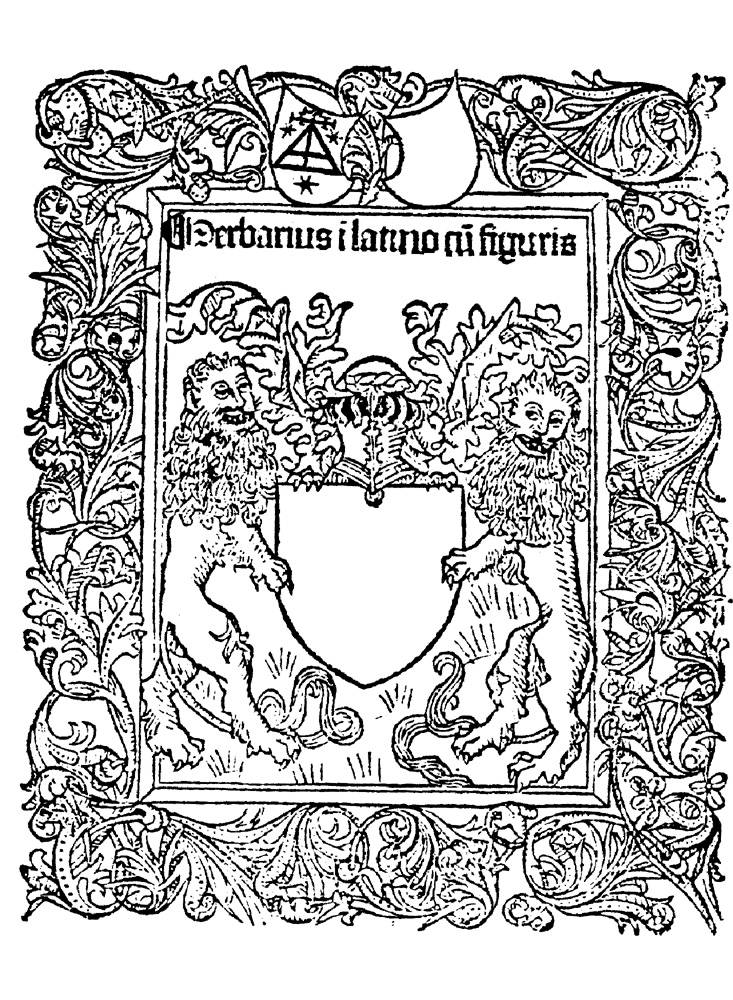
4. Latin, c1485.
[Herbarius]
[Within a woodcut frame that also contains the printer's device:] Herbarius ī latino cū figuris.
4°: [14 2-218 22-246] (unsigned); 174l. Gothic letter, 28-30 lines, with 150 numbered (i-Cl) woodcuts of plants. Capital spaces. Page size: 202 x 135 mm.
Contents: 1/1r, Title.; 1/1v, Woodcut?; 1/2r (=2r), "[R]Ogatu plurimorū īopū nūmorū egētiū ap | potecas refutāciū occasione illa quia necessa | ria ibidē ad corpus egrū spectācia sūt cara sī | plicia ... [line 17] ... Cū ergo corp9 egrū ac | tum curatiuū requirat seu practicū Ob id presēs opu | sculū suā sūpsit denominatōem Aggregatror practic9 | de simplicibus In quo quiuis hominū sibi ipsi sub- | uenire poterit paucis deductis expensis aduersus qzli | bet egritudinē corpus hūanū a vertice capitis ad plā | tas pedū ab intra corpus focasqz affligētē ..."; 1/3r (=3r), "Capitula herba | rū secūdū ordinē | alphabeti | ..."; 2/1r (=5r), Woodcut, (to left) "Absinthiū" (to right) "Alssem | absintheū est calidū ..."; 20/8r (=155r), "Particula secūda de sim. | plicibus laxatiuis linitis. | seu lubricatiuis superio- | rib9 antidotis deseruienti- | bus. | ..."; 24/6r (=174r), line 25, End: "... de esula & pro | uocabunt assellationem."
Very rare. Veldener's Latin edition of the Herbarius. Earlier bibliographies considered this edition to have been published before Schoeffer's herbal. However, Veldener printed this edition after having issued at Kuilenburg a Dutch translation dated 1484. He returned later that year to Louvain and issued this Latin edition for the academic market of the town. Therefore, it is probably later than Schoeffer's edition.
Klebs/Becher: "The figures, except one, are all the same as in the Mainz edition, but generally reversed; plant 2 (Abrotanum) is from a different drawing. Generally, Veldener's woodcuts have a little more work in the way of crossed lines." The text is identical with Schoeffer's edition except that the German names of plants have been replaced with Netherlandish names.
Bibliographical references: BMC XV: 9, 163 [IA 49335]. • Campbell, Annales de la Typographie, 1874-90: no. 916 [Culemborg]. • Choulant, Graphische Incunabeln, 1858: p. 15, no. 4 [Kuilenburg]. • Copinger, Hain's Repertorium, Supplement, 1898-1902: 2916. • Goff: H-59. • Klebs, Incunabula Scientifica, 1938: no. 506.4. • Klebs, Herbals of the Fifteenth Century, 1917-8: p. 87, no. c. • Klebs, Catalogue of Early Herbals, 1925: no. 5. • NUC: 241, 470-1 [NH029029]. • Oates, Cambridge 15th Century Books, 1954: no. 3806. • Pellechet, Catalogue General des Incunables, 1970: no. 1309 [Kuilenburg]. • Polain, Catalogue, 1932: no. 1876. • Proctor, Index, 1898-1906: no. 9299. • Schreiber, Kräuterbücher, 1924: p. iv & lviii [Kuilenburg].
5. Latin, c1485 [Variant edition].
[Herbarius]
Herbarius Latinus (with Dutch synonyms) ... [Louvain:] Jan Veldener [c1485].
4°: [14 2-218 226] b-c6 (unsigned except for the last two quires that are marked on the first leaf only); 174l. Gothic letter, 28-30 lines, with 150 numbered (i-Cl) woodcuts of plants. Capital spaces. Two columns in the tables. Page size: 204 x 141 mm.
Contents: 1/1 (=1), Blank.; 1/2r (=2r), "r[6]Ogatu plurimorū īopū nūmorū egē | tiū appotecas refutātiū occasione illa | q2 necessaria ibidē ad corp9 egrū spec- | tātia sūt cara simplicia ... [line 17] ... Cū ergo corpus egrū actū cuà | tiuū requirat seu practicū. Ob id presens opusculum | suā sūpsit denominacōnē. Aggreator practicus de sī | plicibus. In quo quiuis hominū sibi ipsi subuenire | potèit paucis deductis expensis. aduersus qzlibet egri | tudinem corpus humanū a vertice capitis ad plātas | pedū ab intra corpus focasqz affligentē ..."; 1/3r (=3r), "Capitula herbarū secūdū or | dinem alphabeti. | ..."; 2/1r, Woodcut (to left) "Absintheū" (to right) "Alsem | Absintheū est calidū ..."; 20/8r (=155r), "Particula secūda: de sim | plicibus laxatiuis linitus | seu lubricatiuis superiori- | bus antidotis deseruiēti- | bus. | ..."; c/6v (=174v), line 23, End: "... de esula | et prouocabunt assellationem."
Extremely rare. Second edition of Veldener's Latin herbal. Printed with the same woodblocks and types as the first edition, with only slight differences. Plant 66 is called Flemish Hanencam in this edition and Scarlaech in the first.
Bibliographical references: BMC XV: 9, 163 [IA 49332]. • Campbell, Annales de la Typographie, 1874-90: no. 917. • Choulant, Graphische Incunabeln, 1858: p. 14-5, no. 3. • Copinger, Hain's Repertorium, Supplement, 1898-1902: no. 2915. • Goff: H-60. • Klebs, Incunabula Scientifica, 1938: no. 506.5. • Klebs, Herbals of the Fifteenth Century, 1917-8: p. 87, no. d. • Klebs, Catalogue of Early Herbals, 1925: no. 6. • NUC: 241, 470-1 [NH 0295036]. • Oates, Cambridge 15th Century Books, 1954: no. 3804. • Polain, Catalogue, 1932: no. 1877. • Proctor, Index, 1898-1906: no. 9298.
6. Latin, c1486.
[Herbarius]
Herbarius Latinus (with French synonyms) ... [Paris, Jean Bonhomme, ca. 1486].
4°: 174l. Very rare.
Bibliographical references: BMC XV: 8, 13 [IA 39859]. • Goff: H-61. • Klebs, Incunabula Scientifica, 1938: no. 506.9. • Klebs, Herbals of the Fifteenth Century, 1917-8: p. 88, no. e. • NUC: 241, 470-1 [NH 0295037]. • Proctor, Index, 1898-1906: no. 8050.
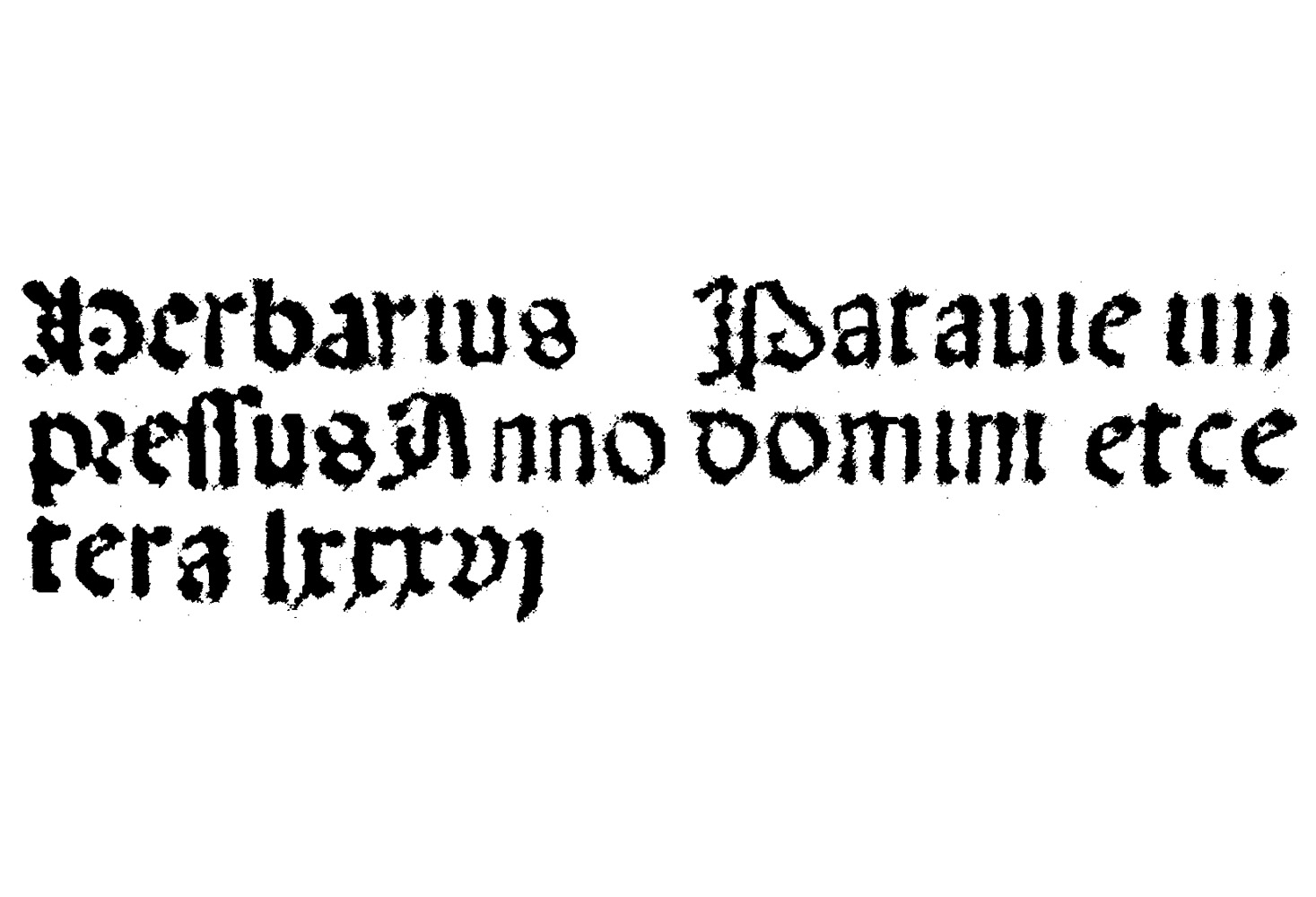
7. Latin, 1486.
[Herbarius]
Herbarius Patauie im | pressus Anno domini et ce | tera lxxxvj.
4°: 174 leaves (156 blank). Gothic letter, 33-34 lines, 150 woodcuts of plants.
Very rare. Second edition of the Passau Herbarius printed by Johann Petri. The woodcuts are the same as those in the first edition.
Bibliographical references: Choulant, Graphische Incunabeln, 1858: p. 15-6, no. 7. • Goff: H-65. • Hain, Repertorium Bibliographicum, 1826-38: H 8446*. • IGI: no. 4673. • Klebs, Incunabula Scientifica, 1938: no. 506.7. • Klebs, Herbals of the Fifteenth Century, 1917-8: p. 90, no. d. • Klebs, Catalogue of Early Herbals, 1925: no. 8. • Martin Bresaluer, Bookseller: cat. 91 (1959), no. 41. • NUC: 241, 470-1 [NH 0295038]. • Pellechet, Catalogue General des Incunables, 1970: no. 1313. • Pritzel, Thesaurus Literaturæ Botanicæ, 1871-3: no. 10754. • Schramm, Bilderschmuck der Frühdrucke, 1922-36: 16, 17. • Schreiber, Kräuterbücher, 1924: p. vii. • Schreiber, Manuel de la Gravure, 1893-1911: 5, 4209.
8. Latin, 1486/7.
[Herbarius]
Herbarius Latinus (with German synonyms) ... Passau, [Johann Petri], 1486.
4°: [14 2-218 2210] (unsigned; 1/1 and 21/2 blank); 174l. Black letter, 32-33 lines, 150 woodcuts of plants numbered i-cl. Page size: 208 x 152 mm.
Contents: 1/2r (=2r), "[R6]Ogatu plurimo[old aux] | inopum nūmo[old aux] egentium ... (line 20) ... Cum ergo corpus | egrum actū curatiuū requirat seu practicū. Ob id | presens opusculū suam sumpsit denomiatōnem. Ag | gregator practicus de simplicibus. In quo quiuis | hominū sibiipsi subuenire poterit paucis deductis | expēsis aduersus quālibet egritudīem corp9 huma | nū a vertice capitis ad plantas pedū ab intra cor= | pus focasqz affligentē ..."; 1/3r (=3r), "Capitula herbarum secun | dum ordinem alphabeti."; (=155r), "Particula secunda De | simplicibus laxatiuis li= | nitiuis seu lubricatiuis | superiorib[Backwards c] antiquis de= | seruiētibus."; (=174v), End: "... de esula et prouocabunt assellatōnem."
Very rare. Third and last Passau edition, with "most of the extant copies imperfect" (Klebs/Becher). The woodcuts are the same as those in the other two editions, but they and the type is becoming noticeablly worn.
Bibliographical references: BL. • BMC XV: 2, 616 [IA 11326]. • Choulant, Graphische Incunabeln, 1858: p. 16, no. 8. • Cleveland Herbal & Botanical Collections, 1992: no. 12. • Goff: H-66. • Hain, Repertorium Bibliographicum, 1826-38: H 8447* [Imperfect copy]. • Klebs, Incunabula Scientifica, 1938: no. 506.8. • Klebs, Herbals of the Fifteenth Century, 1917-8: p. 87, no. b. • Klebs, Catalogue of Early Herbals, 1925: no. 9. • Nissen (BBI): no. 2312. • Pellechet, Catalogue General des Incunables, 1970: no. 1310 [press of J. Alacraw and Sigismundus Mair]. • Schramm, Bilderschmuck der Frühdrucke, 1922-36: 16, 17. • Schreiber, Kräuterbücher, 1924: vii. • Schreiber, Manuel de la Gravure, 1893-1911: 5, 4211.

9. Latin, 1491 [27 October].
[Herbarius]
[Within an elaborate woodcut border surmounted by a scene showing two figures in discussion:] Arnoldi De Nova Villa [3 vertical dots] Avicenna. | [Dark C] Incipit Tratatus de uirtutibus herbarum. | [R5]ogatv Plvrimorvm Inopvm | [...15 lines of text...].
4°: [-]4 a-x8 ($4 signed; c3 as c2, o3 as p3; x8 blank); 172l.; no pagination or foliation. 150 text woodcuts of plants (numbered I-CL). Colophon (t6v): "[Dark C] Finiunt Liber uocatur herbolarium de uirtutibus her- | barum. Impressum Vincentiæ per Magistrum Leonar | dum de Basilea & Guilielmum de Papia Socios. Anno sa- | lutis. M. cccc. lxxxxxi. die. xxvii. meñ. Octob. | Deo. Gratias" (=27 October 1491). Some variant copies have the incorrect reading, "Ncipit" on [-]2r. Page size: 197 x 141 mm.
Contents: [-]1 (=1), Blank.; [-]2r-[-]4v (=2r-4v), Woodcut title, followed by the Incipit and Prologus .; a1r-t6v (=5r-154v), Text of herbal.; t6v (=154v), Colophon.; u1r-x7v (=155r-171v), "Particula secunda ..."; x8 (=172), Blank.
Very scarce. This is the first edition of the Herbarius to be printed in Italy, which is why the German synonyms have been omitted. It was printed by Leonardus Achates and Guilielmus de Papia [see notes below]. The woodcuts of the plants have been influenced by the the design of the German cuts, but in this edition they are newly executed with somewhat finer detail. The text and arrangement are identical to Schoeffer's edition, but without the German synoyms.
Although new to this work, the title woodcut of two figures was used the year before in an edition of Piero Crescentio's Opus Raralium Commodorum to represent Crescentio preparing the book for his patron Charles of Anjou. In the present work, the cut is used to represent Arnoldus de Villa Nova discussing botany with Avicenna. The omission of the woodcut figures in subsequent editions where the names of Arnoldus and Avicenna were retained in type in their present location led to false idea of authorship of this work by Arnoldus.
The numbers to the woodcuts 113 and 119 are exchanged by misprint.
Leonardus Achates. (Born: ; Died: 1491) Italian printer. Achates was the first printer in Vicenza.
Guilielmus De Papia. (Born: ; Died: ) Italian printer.
Bibliographical references: Anderson, Illustrated History of the Herbals, 1997: 85. • BMC XV: 7, 1033 [IA 31731]. • Choulant, Graphische Incunabeln, 1858: 16, no. 9. • Cleveland Herbal & Botanical Collections, 1992: no. 15. • Copinger, Hain's Repertorium, Supplement, 1898-1902: no. 649a. • Goff: H-68. • Hain, Repertorium Bibliographicum, 1826-38: no. HC 8451. • IGI: no. 4676. • Klebs, Incunabula Scientifica, 1938: no. 506.10. • Klebs, Herbals of the Fifteenth Century, 1917-8: p. 91, no. f. • Klebs, Catalogue of Early Herbals, 1925: no. 10. • Nissen (BBI): no. 2307. • NUC: 241, 470-1 [NH 0295042]. • Payne, `Herbarius' and `Hortus Sanitatis', 1901: pp. 86/87 & 91, no. f. • Pellechet, Catalogue General des Incunables, 1970: no. 1314. • Pritzel, Thesaurus Literaturæ Botanicæ, 1871-3: no. 10755. • Proctor, Index, 1898-1906: no. 7131. • Sander, Livre à Figures Italien, 1941: no. 610. • Wellcome Catalog (Books): 1, 3100. (Achates) ADB. • DBA: I 3, 214; II 5, 93-95. • NDB. • WBI. (De Papia)
10. Latin, 1499 [14 December].
[Herbarius]
Inicipit Tractatus de | virtutibus herbarum.
4°: A4 a-x8 ($4 signed; x8 blank); 172l.; no pagination or foliation. Roman letter, 27, 28 & 37 lines, with 150 woodcuts of plants. Colophon (x7v): [Dark C] Impressum Venetiis per Simonem Pa | piensem dictum Biuilaquam Anno Do | mini Iesu Christi. 1499. die. xiiii. Decēbris.
Contents: A1r, Title.; A1v, Blank.; A2r, No woodcut so text starts, "Arnoldi de nova villa Avicenna | Rogatu plurimorum ..."; a1r-s8v (=5r-154v), Text of herbs.; t1r-x7v (155r-171v), Text of other parts.; x7v, Colophon.
Rare. Second edition of the Herbarius printed in Italy by Simon Bevilaqua, reprinted from the 1491 edition of Achates. The woodcuts of the plants are from the same blocks. The title woodcut representing Arnoldus de Nova Villa and Avicenna is omitted, but the names are retained (see preceding entry). The woodcuts numbered 113 and 119 are exchanged as in the 1491 edition. The woodcut of Mandragora is printed upside down and misnumbered XCVIIII instead of XCIIII.
Bibliographical references: BMC XV: 5, 524 [IA 23999]. • Choulant, Graphische Incunabeln, 1858: p. 16, no. 10. • Cleveland Herbal & Botanical Collections, 1992: no. 21. • Essling, Livres à Figures Vénitiens, 1907-14: 2, 1190. • Goff: H-69. • Hain, Repertorium Bibliographicum, 1826-38: HC 1807 [Arnoldus]. • IGI: no. 4677. • Klebs, Incunabula Scientifica, 1938: no. 506.11. • Klebs, Herbals of the Fifteenth Century, 1917-8: p. 92, no. h. • Klebs, Catalogue of Early Herbals, 1925: no. 11. • Nissen (BBI): no. 2308. • NUC: 241, 470-1 [NH 0295043]. • Payne, `Herbarius' and `Hortus Sanitatis', 1901: p. 87. • Pellechet, Catalogue General des Incunables, 1970: no. 1315 [variant?]. • Pritzel, Thesaurus Literaturæ Botanicæ, 1871-3: no. 10757. • Proctor, Index, 1898-1906: no. 5415. • Sander, Livre à Figures Italien, 1941: no. 612. • Schullian & Sommer, Catalogue of Incunubula, 1948: no. 237. • Wellcome Catalog (Books): 1, 3101.
11. Latin, 1502.
[Herbarius]
Incipit tractatus de virtutibus herbarum. | Arnoldi de noua villa Auicenna. Imbressum Venetiis per christophorum de pensis anno domini nostri Jesu Christi 1502, Julius, die vero 4.
4°: 172 leaves, with 150 numbered woodcuts of plants, Luc. Ant. Giunta's printer's device printed in red on the title page. Woodcut capitals.
Rare. Second edition issued at Venice, the third printed in Italy Christophorus de Pensis for Luc. Ant. Giunta. Based upon the title page's device, this edition was printed for Luc. Ant. Giunta. Woodcuts are from the same blocks as used in the 1491 and 1499 editions. The woodcut of Mandragora by misprint numberd XCVIIII instead of XCIIII as in the 1499 edition. Woodcut XXIII is printed upside down.
Not noticed by Renouard in his list of Giunta's editions (Paris, 1834).
Bibliographical references: Choulant, Graphische Incunabeln, 1858: p. 16-7, no. 11 [not seen]. • Essling, Livres à Figures Vénitiens, 1907-14: 2, no. 1191 [wrong collation]. • Klebs, Herbals of the Fifteenth Century, 1917-8: p. 14, no. f [describes an imperfect copy]. • Klebs, Catalogue of Early Herbals, 1925: no. 12. • NUC: 241, 470-1 [NH 0295046]. • Pritzel, Thesaurus Literaturæ Botanicæ, 1871-3: no. 10756. • Reichling, Appendices ad Hainii-Copingeri, 1905-14: no. 404 [followed by Klebs in his description].
12. Latin, 1509.
[Herbarius]
Incipit Tractatus De | Uirtutibus her | barum.
4°: A4 a-x8 ($4 signed; x8 blank); 172l.; no pagination or foliation. With 150 woodcuts in the text numbered I-CL. Woodcut capitals. Colophon (x7v): [Dark C] Impressum Venetiis per Ioannem rubeum & | Bernardinū fratres Vercellenses. Anno | domini. M. D. VIIII. die. xv. marcii. Page size: 210 x 150 mm.
Rare. This is the third edition of the 'Herbarius Latinus' printed by Johannes and Bernarinus Rubeus in Venice, and the fourth printed in Italy. With two exceptions, these are the blocks cut for the 1491 Vicenza edition, which were transferred to Venice and used by Simone Bevilacqua for his 1499 edition; two of the blocks are copies of the originals, with one reversed. The blocks were used again for the 1502 Giunta edition, which the above is a page-for-page reprint of. The preface attributes the work to Arnoldus de Villanova, as does the 1502 edition, which was copying an error in the text of the 1499.
Despite the fact that the 'Herbarius' originated in Germany, it 'sold as well in Italy, as it did in Germany, if not better. There its second section may have contributed to its success, for it was concerned with materials of medicine that were commonly available in the shops of apothecaries and spice merchants... The second section has 96 chapters, though many of them are very brief. They deal with the following: laxatives; aromatics, fruits, seed, and plants of garden and orchard; gums and resins; salts; minerals and stones; and a variety of animals and their products, such as goose-grease, cheese, honey, and ivory"(Anderson, An illustrated history of the herbals p. 86). The Italian woodcuts are based on the German'Herbarius' cuts 'but all are newly designed, being finer in execution and the lines more delicate, and for the greater part quite different' (Klebs). Nissen considered them more delicate and Arber 'more ambitious... and, on the whole... more naturalistic' (Herbals p. 192).
Bibliographical references: Adams, Cambridge Books, 1967: H-298. • Choulant, Graphische Incunabeln, 1858: p. 17, no. 12. • Cleveland Herbal & Botanical Collections, 1992: no. 25. • Essling, Livres à Figures Vénitiens, 1907-14: 2, 1192. • Klebs, Catalogue of Early Herbals, 1925: no. 13. • Nissen (BBI): no. 2310. • NLM 16th Century Books (Durling): no. 2268. • NUC: 241, 470-1 [NH 0295048]. • Pritzel, Thesaurus Literaturæ Botanicæ, 1871-3: no. 10758. • Wellcome Catalog (Books): 1, 3103.
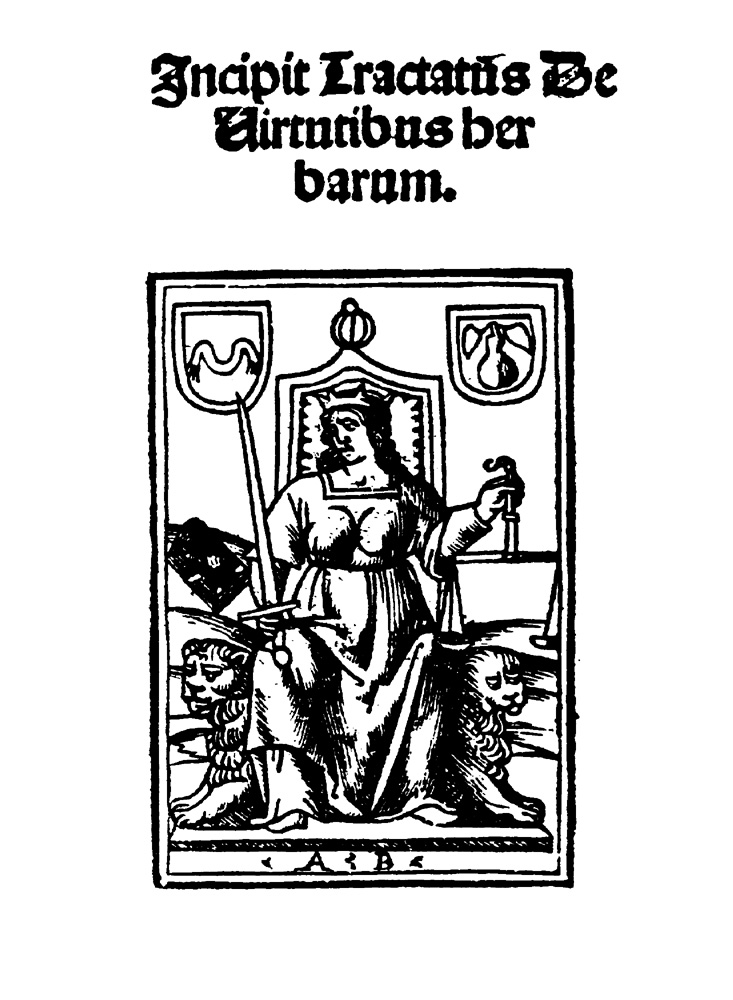
13. Latin, 1520.
[Herbarius]
Incipit Tractatus De | Virtutibus her | barum. | [Printer's woodcut device].
4°: A4 a-x8 (A2 missigned A; x8 blank); 172l.; [8] p., I-CLl., [34] p. Printer's device (Justice) on the title and 150 woodcuts of plants in the text. Colophon (x7v): [Dark C] Impressum Venetiis per Alexandrum de Bindonis. | Anno Domini. M.D.XX. die .4.Aprilis.
Very scarce. Printed by Alexander de Bindonis, this is the fifth Venice edition (sixth printed in Italy) and the last edition of the Latin Herbarius. The woodcuts are the same as the 1509 edition. Three woodcuts bear the wrong numbers: CLVII instead of CXLVIII, CXXIIII for CXXX, and LI for LII. Otherwise, it appears to be a page for page reprint of the 1509 Venice edition.
Bibliographical references: Essling, Livres à Figures Vénitiens, 1907-14: 2, no. 1193. • Hunt Botanical Catalog: no. 19. • Klebs, Herbals of the Fifteenth Century, 1917-8: p. 88, no. g [imperfect copy]. • Klebs, Catalogue of Early Herbals, 1925: no. 14. • Kristeller, Italienische Buchdruckerzeichen, 1893: no. 194. • Mortimer Italian Books: no. 228. • Nissen (BBI): no. 2311. • NUC: 241, 470-1 [NH 0295049].
Dutch editions
14. Dutch, 1484 [Dutch transl.].
[Herbarius]
Kruydboek [in Dutch, with Latin synonyms in the text] ... [Louvain:] Jan Veldener, 1484.
4°: [1-218 224 23-268 274] (unsigned); 208l.; no pagination, foliation or signiature marks. Capital spaces. 150 woodcuts of plants in the text numbered i-cl. Signiatures in manuscript are recorded in the British Library copy as follows: *8 a-u8 x4 A-D8 E4. Page size: 185 x 120 mm.
Contents: 1/1r (=1r), Blank.; 1/1v (=1v), woodcut.; 1/2r (=2r), "Dye prologhe de ouersetters vyt | den latyn in dyetsche. | G [to right, printed vertically] Odes vrese dije wyl mij omvaē. dat | [horizontally] ick altijt werkē moet bestaē ..."; 1/3v (=3v), line 3: "Dye voerspraeck dees meesters dees boeckx daer | dit van worde te worde vuyt gheseyt es volght | hier nae. | [W]Ant veel lyen mids der armoeden ..."; 1/5v, [Table] "[D]ye eerste partikel dees boeckx spreeckt van | de crachten der crudē ..."; 1/8v (=8v), Printer's device.; 2/1r (=9r), [woodcut], to left: "Absinthiū"; to right: "Alsen | [A]lsen of wit alsen of absinthiū es heet ..."; 22/4v (=172v), line 5: "Hier endet die eerste partikel dees boeckx | [woodcut]."; 23/1r (=173r), "Die tweeste partikel des boeckx es vā medi= | cinen ..."; 27/4r (=208r), line 19, Colophon: "Ghemaeckt int iaer ons | heerē .M. CCCC. en. lxxxiiij."; 27/4v (=208v), [woodcut].
Very rare. Printed by Johann Veldener [see note below]. The woodcuts which accompany each of the 150 plant descriptions are copies in reverse of those in the Latin edition printed by Schoeffer, Mainz, 1484.
Johann Veldener. (Born: ; Died: c1487) Dutch printer. Native of the Diocese of Würzburg, Veldener set up his first press in the town of Louvain in 1473. In 1478, he moved to Ultrecht and reestablished his print shop there.
Bibliographical references: BL [IA 49330]. • BMC XV: 9, 162 [IA 49330]. • Campbell, Annales de la Typographie, 1874-90: no. 918. • Choulant, Graphische Incunabeln, 1858: p. 17, no. 13. • Goff: H-67. • Hain, Repertorium Bibliographicum, 1826-38: no. 8449. • Klebs, Incunabula Scientifica, 1938: no. 506.3. • Klebs, Herbals of the Fifteenth Century, 1917-8: p. 89-90, no. b. • Oates, Cambridge 15th Century Books, 1954: no. 3641. • Polain, Catalogue, 1932: no. 1879. • Proctor, Index, 1898-1906: no. 9158 [Kuilenburg]. (Veldener) ADB: 39, 571-2. • Biografisch Woordenboek België. • Biografisch Woordenboek Nederland. • BMC XV: ??, ??. • Geldner, Die deutschen Inkunabeldrucker, 1968-70: 2, 319, 323-5 & 338-40. • Lexikon des Buchwesens: 2, ??.
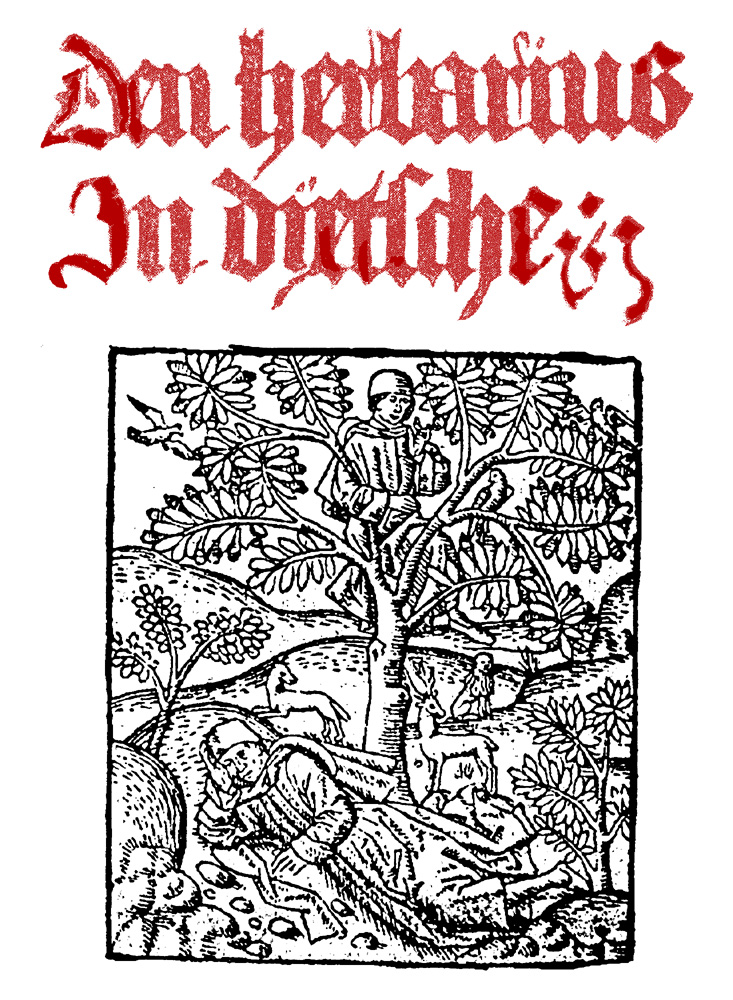
15. Dutch, 1511.
[Herbarius]
[In red:] Den herbarius | In Dijetsche [ornament] | [in black, large woodcut].
4°: a-c6 d8 e4 f8 g-y8.4 z8 &4 A-D4.8 E4 (Gatherings in 6's and 8's are signed on $1 and $3, while gatherings in 4's are signed on $1 only); 174l.; no pagination or foliation. Gothic type.
Contents: a1r, Title.; a1v, Blank.; a2r, "Dye prologhe des ouersetters. | wt den latijn in dyetsche | ..."; b1r, Text of herbs begins.; E3v, colophon: Gheprent tantwerpen doer die camer poert inden | gulden eenhoren bi my Willen vorsterman.; E4v, Printer's device.
Very rare. This second printing of the Dutch translation is known in only a few copies. It was printed by Willen Vorsterman.
Bibliographical references: Choulant, Graphische Incunabeln, 1858: p. 17, no. 14. • Hunt Botanical Catalog: no. 13. • Nijhoff & Kronenberg, Nederlandsche Bibliographie: no. 1049 [wrong collation]. • Nissen (BBI): no. 2314.
Italian editions
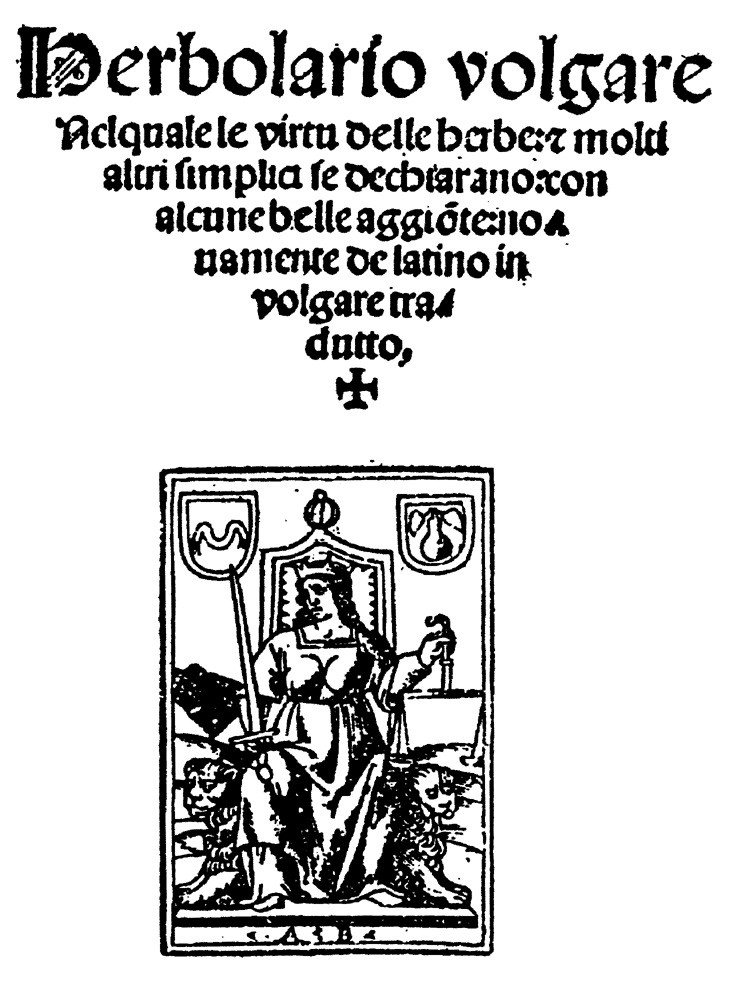
16. Italian, 1522 [Translation, First edition].
[Herbarius]
Herbolario volgare | Aclquale le virtu delle berbe:& molti | altri simplia le dechiarano:con | alcune belle aggiōte:no a | namente de latino in | volgare tra= | dutto, | [Cross] | [Woodcut, printer's device].
8°: [8] p., 150l. (numbered i-cl), [48] p., with 150 woodcuts and printer's device on the title and at end of text. Page size: 156 x 102 mm.
Rare. First edition in Italian, with the woodcuts printed from blocks of the 15th century Latin editions, published in Italy. First edtiion of the Herabarius translated into Italian. A preface by the translator and an index of diseases with their remedies is newly added.
The woodcuts are printed from the same blocks already used in the Latin editions, published in Italy.
Bibliographical references: Essling, Livres à Figures Vénitiens, 1907-14: 2, 1194. • Klebs, Catalogue of Early Herbals, 1925: no. 15. • Nissen (BBI): no. 2316. • NLM 16th Century Books (Durling): no. 2271. • NUC: 241, 470-1 [NH 0295051]. • Payne, `Herbarius' and `Hortus Sanitatis', 1901: p. 88. • Pritzel, Thesaurus Literaturæ Botanicæ, 1871-3: no. 10764. • Wellcome Catalog (Books): 1, 163.
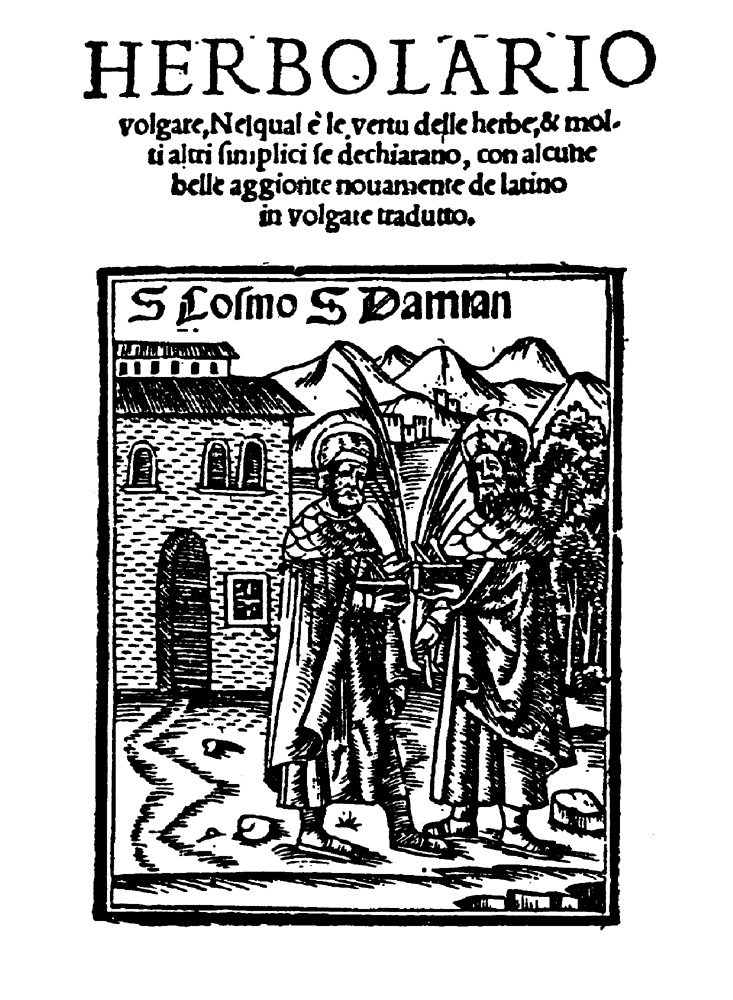
17. Italian, 1534 [Translation, 2nd edition].
[Herbarius]
Herbolario | volgare, Nelqual è le vertu delle herbe;& mol- | ti altri simplici se dechuarano, con alcune | belle aggionte nouamente de latino | in volgate tradutto. | [Woodcut showing Saints Cosmo and Damien in a landscape].
8°: aa6 A-X8 Y6; 180l.; [12] p., 151l. (numbered i-cli), [46] p., with 151 woodcuts of plants, etc. With title woodcut (representing the Saints Damian and Cosmas in a landscape), woodcut of the Virgin and Child on aa6v and a full page woodcut of the Virgin Mary and Christ on 150. Printer's device on the last leaf. Colophon: Stampato ne Venetia, per Gioãni Andrea Vauassore detto Guadagnino & fratelli, 1534.
Contents: aa1r (=1r), Title.; aa1v (=1v), "Alli lettori salute" [=preface of the translator].; aa2r-aa2v (=2r-2v), "Prologo de lo Autore. | Mosso da priegi, ..." [=translation of Rogatu plurimorum].; aa3r-aa6r (=3r-6r), "Tabula ordinata per alphabeto" [=index].; aa6v (=6v), Woodcut of the Annunciation, enclosed within an ornamental frame.; A1r-T8v (=7r-158v), Text of the section on herbs.; V1r-X8v (=159r-174v), Text of the other sections.; Y1r-Y6r (=175r-180r), "Tabula ... a ogni egritudine."; Y6v (=180v), Blank.
Rare. Second edition of the Italian translation. The order of the herbs is slightly different than the 1522 edition. Two additional chapters are present: Mele (Honey) and Vino e aceto. The illustrations for these additions (one representing two tree trunks with bees, the other a wine cellar with casks) are not copied from any edition of the Herbarius, but are copied from the Latin Hortus Sanitatis. The title woodcut is probably printed here for the first time and copies of it appear in the later Herbolario editions. Essling reproduces two variants of this cut with the two medical saints (2, p. 462) from later editions of the Italian translation (1536 and 1539).
Bibliographical references: Hunt Botanical Catalog: no. 34. • Klebs, Catalogue of Early Herbals, 1925: no. 16. • NUC: 241, 470-1 [NH 0295052].
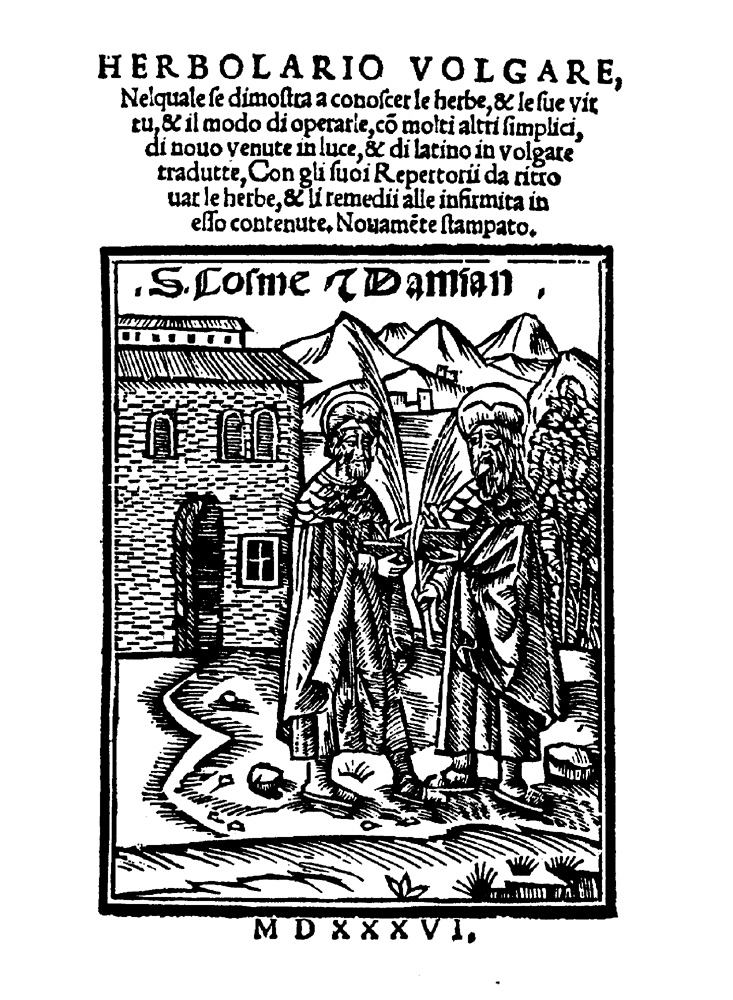
18. Italian, 1536.
[Herbarius]
Herbolario Volgare | Nelqual se dimostra a conoscer le herbe, & le sue vir | tu, & il modo di operar e, cō molti altri simplici, | di nouo venute in luce, & di latino in volgare | tradutte, Con gli suoi Repertorii da ritro | uar le herbe, & li remedii alle infirmita in | esso contenute. Nouamēte stampato | [Woodcut of Saints Cosmas and Damian] | M D XXXVI.
8°: [Maltese Cross]12 A-Z8 AA4 ($4 signed); 200l.; no pagination or foliation, with woodcut on the title page and 170 woodcuts in the text, 168 of which represent plants. Colophon (AA4): Stampato in Vinegia a santo Moyse al segno de | Langelo Raphaello, Per Francesco di Alessan | dro Bindone, & Mapheo Pasini, compa | gni. Del mese di Giugno. Lanno | M D XXXVI.
Very scarce. Third Italian edition, enlarged by an additional 20 plant description with accompanying woodcuts. It is the only edition of the Herbarius that has 170 woodcuts of plants.
Bibliographical references: Choulant, Graphische Incunabeln, 1858: p. 17, no. 15 [describes a copy without the title page]. • Cleveland Herbal & Botanical Collections, 1992: no. 48. • Essling, Livres à Figures Vénitiens, 1907-14: 2, 1195 [reproduces the first cut]. • Klebs, Catalogue of Early Herbals, 1925: no. 17. • Nissen (BBI): no. 2316. • NLM 16th Century Books (Durling): no. 2271. • NUC: 241, 470-1 [NH 0295054-5]. • Payne, `Herbarius' and `Hortus Sanitatis', 1901: p. 88. • Pritzel, Thesaurus Literaturæ Botanicæ, 1871-3: no. 10765. • Sallander, Bibliotheca Walleriana, 1955: no. 4362. • Wellcome Catalog (Books): 1, 3104.
19. Italian, 1539.
[Herbarius]
Herbolario volgare, Nelqual è dimostza a conoscer la herbem & le sue virtu: & il di oparario: con molti altri simplici: di novo venute in luce: & di latino in volgare tradutte: con gli suoi repertorii da ritrovar le herbe: & li remedii alle infirmita in esso contenute: con alchune altre notabile additioni agionte che ne gli altri non li sono ... [Venetia, Giovan Maria Palamides, 1539].
8°: [12] p., 151l. (numbered i-151), [44] p; 179 leaves, with title woodcut of Saints Cosmas and Damian, full page woodcut on leaf 6v (Annunciation) and 151 woodcuts of plants in the text. Printer's device (Saint John the Baptist) on the last leaf.
Very scarce. Fourth edition of the Italian version. An almost exact reprint of the 1534 edition. Becher catalog: "All the woodcuts are derived from the Latin Hortus Sanitatis, but are not printed from the blocks used in the 1534 edition. The text of the first page printed in red except for the first word. The woodcuts 109, 143, and 149 are slightly different fro the corresponding ones in the 1534 edition; woodcuts 2-3 are exchanged by misprint."
Bibliographical references: Choulant, Graphische Incunabeln, 1858: p. 18, no. 16. • Essling, Livres à Figures Vénitiens, 1907-14: 2, 1196. • Klebs, Catalogue of Early Herbals, 1925: no. 18. • Nissen (BBI): no. 2318. • NUC: 241, 470-1 [NH 0295057]. • Payne, `Herbarius' and `Hortus Sanitatis', 1901: p. 88. • Pritzel, Thesaurus Literaturæ Botanicæ, 1871-3: no. 10766 [incorrect collation].
20. Italian, 1540.
[Herbarius]
Herbolario | volgare, Nelqual è le vertu delle herbe; & mol- | ti altri simplici se dechiarano, con alcune | belle aggionte nouamente de latino | in volgate tradutto. | [Woodcut showing Saints Cosmo and Damien in a landscape].
8°: aa6 A-X8 Y6; 180l.; [12] p., 151 leaves (numbered i-cli), [46] p., with 151 woodcuts of plants, etc. With title woodcut (representing the Saints Damian and Cosmas in a landscape), woodcut of the Virgin and Child on aa6v and a full page woodcut of the Virgin Mary and Christ on 150. Colophon (Y6r): Stāpato ne la inclita citta di Venetia con accuratissima diligentia per Gioanni Maria Palamides Nell' anno M.D.XL. Registro.
Contents: aa1r (=1r), Title.; aa1v (=1v), "Alli lettori salute" [=preface of the translator].; aa2r-aa2v (=2r-2v), "Prologo de lo Autore. | Mosso da priegi, ..." [=translation of Rogatu plurimorum].; aa3r-aa6r (=3r-6r), "Tabula ordinata per alphabeto" [=index].; aa6v (=6v), Woodcut of the Annunciation, enclosed within an ornamental frame.; A1r-T8v (=7r-158v), Text of the section on herbs.; V1r-X8v (=159r-174v), Text of the other sections.; Y1r-Y6r (=175r-180r), "Tabula ... a ogni egritudine."; Y6v (=180v), Blank.
Rare. Printed in Venice by Giovan Maria Palamides in 1540.
Bibliographical references: Choulant, Graphische Incunabeln, 1858: p. 18-9, no. 17. • Hunt Botanical Catalog: no. 46. • Nissen (BBI): no. 2319. • NUC: 241, 470-1 [NH 0295058]. • Payne, `Herbarius' and `Hortus Sanitatis', 1901: pp. 88-9. • Pritzel, Thesaurus Literaturæ Botanicæ, 1871-3: no. 10767.
21. Italian, 1555.
[Herbarius]
Herbolario | volgare, Nelqual e le virtv delle herbe, & mol- | ti altri simplici se dechiarano, con alcune | belle aggionte nouamēte de latino | in volgare traduto. | [Woodcut showing Saints Cosmo and Damien in a landscape].
8°: aa6 A-X8 Y6 (Y6 blank); 180l.; no pagination, with title wood cut of the Saints Cosmas and Damian, and a woodcut of the Annunciation, enclosed within an ornamental border on leaf aa6v, and 151 woodcuts of plants in the text.
Contents: aa1r (=1r), Title.; aa1v (=1v), "Alli lettori salute" [=preface of the translator].; aa2r-aa2v (=2r-2v), "Prologo de lo Autore. | Mosso da priegi, ..." [=translation of Rogatu plurimorum].; aa3r-aa6r (=3r-6r), "Tabula ordinata per alphabeto" [=index].; aa6v (=6v), Woodcut of the Annunciation, enclosed within an ornamental frame.; A1r-T8v (=7r-158v), Text of the section on herbs.; V1r-X8v (=159r-174v), Text of the other sections.; Y1r-Y6r (=175r-180r), "Tabula ... a ogni egritudine."; Y6v (=180v), Blank.
Rare. Fifth edition of the Italian edition printed in Venetia by Giovanni Padoana. The woodcuts are printed from the blocks of the 1539 edition, including the title woodcut. The annunciation cut appears for the first time (without border) in an (Italian) Life of the Virgin, 1492. Klebs/Becher says that the signiatures A-U are made up of quires from the 1540 edition, while the other signiatures are reset.
Bibliographical references: Graesse, Trésor de Livres Rares, 1859-69: 3, 245. • Hunt Botanical Catalog: no. 75. • Klebs, Catalogue of Early Herbals, 1925: no. 19. • Nissen (BBI): no. 2320. • NUC: 241, 470-1 [NH 0295060].
22. Italian, 1555 [Variant edition].
[Herbarius]
Herbolario | Volgare: | Nel Qvale Le Virtv Delle | herbe: & molti altri simplici | se dechiarano: con alcune | belle aggionte noua- | mēte de latino | in volgare traduto. | [ornament] | [Printer's mark].
8°: aa6 A-X8 Y6 ($4 signed; Y6 blank); 180l.; no pagination or foliation, with a printer's device (depicting Temperance) on the title page, 151 woodcuts of plants in the text and on leaf 6v a woodcut of a scholar sitting at his desk, attended by four others standing. Colophon (Y5v): [Dark C] Stampato in Venetia | per gli Heredi di Gio= | anne Padoano. | M D L V.
Very rare. A different edition of the 1555 edition. Several chapters are illustrated by different woodcuts of the plants than in the the other 1555 edition. The title contains a printer's device and the cut of the Annunciation is replaced by a different cut of a scholar.
Bibliographical references: Cleveland Herbal & Botanical Collections, 1992: no. 76. • Klebs, Catalogue of Early Herbals, 1925: no. 20. • Nissen (BBI): no. 2319.
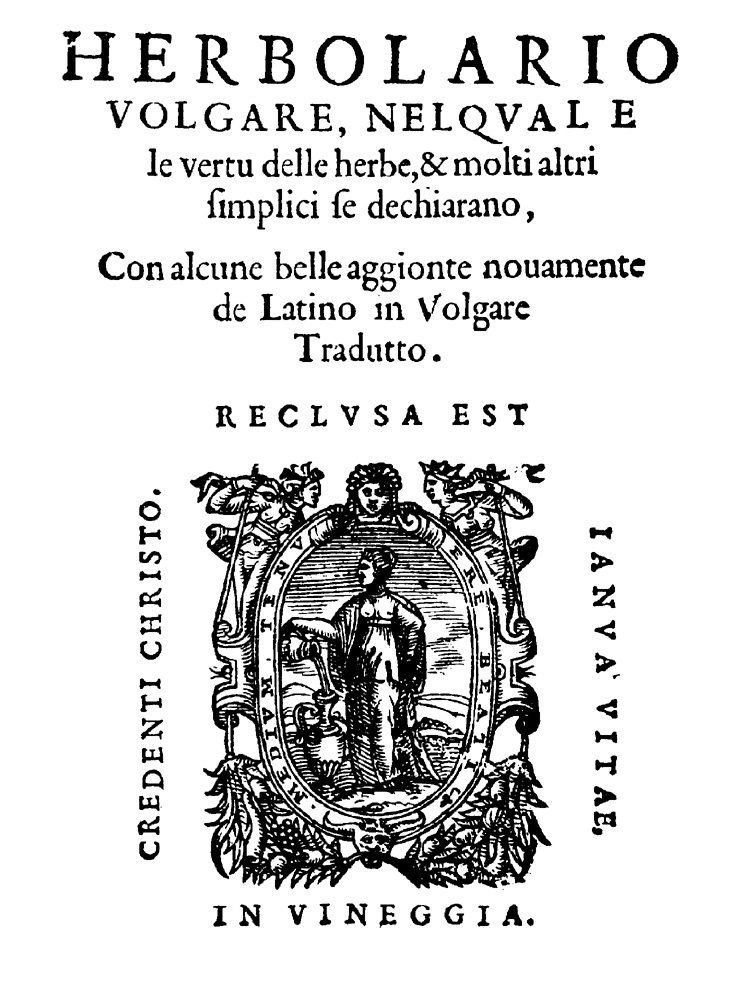
23. Italian, 1565.
[Herbarius]
Herbolario | Volgare, Nelqval E | le vertu delle herbe, & molti altri | simplici se dechiarano, | Con alcune belle aggionte nouamente | de Latino in Volgare | Tradutto. | Reclvsa Est | [Left-hand side of ornament, vertical text reading bottom to top:] Credenti Christo. | [Right-hand side of ornament, vertical text reading top to bottom:] Ianva Vitae. | [ornament] | In Vineggia.
8°: aa8 A-Y8; 182l.; no pagination or foliation. Printer's device on the title page, with 151 woodcuts of plants, etc. contained in the text.
Rare. The eighth edition and last of the early herbals to be published. The woodcuts are taken from the blocks of the 1539 edition, with only a few being different.
Bibliographical references: Klebs, Catalogue of Early Herbals, 1925: no. 21. • Nissen (BBI): no. 2321. • NUC: 241, 470-1 [NH 0295061]. • Plesch, Stifung für Botanik Auction, 1975-6: no. 338.
Gart der Gesundheit
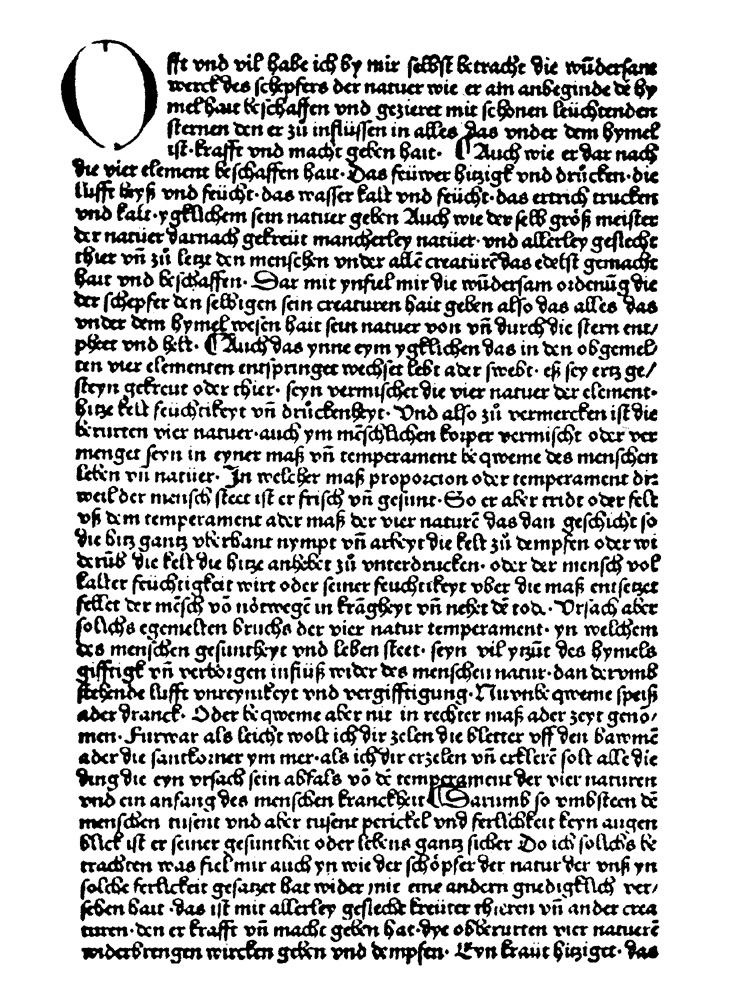
24. German, 1485 [First edition].
[Gart]
Gart der Gesundheit ... Mainz, [Peter Schoeffer], 28 March 1485.
2°: 1-438 44-454 468 (unsigned; 46/8 blank); 360l.; no pagination, foliation or signiature marks. Capital spaces. Full-page woodcut on the verso of the first leaf (three sitting savants, attended by ten standing men and blank heraldic shield above) a smaller cut before the fourth part (a physician holding a urine flask and a women with a hamper), 368 cuts of plants and 11 of animals. Page size: 288 x 202 mm.
Contents: 1/1r (=1r), Blank.; 1/1v (=1v), Full-page woodcut showing 13 figures surmounted by an arch decorated with foliage and other ornaments, from which hangs a blank shield.; 1/2r-1/3v (=2r-3v), Preface, with text starting: "[O5]fft vnd vil habe ich by mir selbst betracht die wūndersam | werck des schepfers der nature ..."; 1/4r-46/7r, Text in 435 chapters.; 46/7v, Colophon (in red): "Disser Herbarius ist czu | mencz gedruckt vnd geen= | det uff dem xxviij dage des | mercz. Anno. M. cccc. lxxxv. | [printer's device]."; 46/8 (=360), Blank.
Edition princeps. Extremely rare. The second herbal to be printed by Peter Schoeffer came from his press at Mainz on the 28th of March, 1485. It immediately eclipsed all previous works of a similar nature, and formed the foundation for all herbals that followed it. Although it bore no title page, Der Gart was clearly and definitively named by Schoeffer in the book's own foreword. There it was called Ortus Sanitatis and its German equivalent, Gart der Gesuntheyt, the Garden of Good Health. Despite that fact, cataloguers and bibliographers, for nonsensical reasons best left to them to explain, decided to call the work variously Herbarius zu Teutsch, Hortus Sanitatis Germanice, and the Smaller Hortus or Hortus Minor. None of that identified the book properly, but it did succeed in confusing three entirely separate publications, Schöffer's Herbarius and Gart der Gesuntheyt, and Meydenbach's Hortus Sanitatis of 1491. The works held 150, 435, and 1066 chapters respectively, so it is impossible to understand how anyone could fail to distinguish them. Nothing, however, is beyond the powers of the cloistered specialists. It was not until 1925, when Arnold Klebs established the system of referring to the books as the Herbarius, Der Gart, and the Hortus, that the tangle was resolved. The sad fact remains, though, that not all libraries have taken Klebs's advice even as yet.
The 435 chapters of Der Gart are written in the dialect of southern Germany, 368 of them dealing with plants of medicinal value; and eleven with animal substances. Each of those is illustrated with a woodcut picturing its subject, and the majority are highly identifiable, well drawn, and artistically executed. Understandably the cuts of material outside the artists' direct experience are either poorly done or fictitious. That was a consequence of their arrival in Europe, from distant parts of Asia and Africa, in dry, shrunken, broken, or powdered condition. Some fifty-six chapters were left unillustrated since their commonly known substances, such as cheese, water, flour or lead, did not seem to call for picturization. Among them are four liquids, fourteen items of animal origin, fifteen plant drugs and products, and twenty-three minerals.
The artist responsible for the designs remains unknown, although the name of Erhard Reuwich, or his studio, is most often put forward on stylistic grounds. That remains debatable in the absence of any contract or other record. The same anonymity attaches to the text, which is obviously a compilation, and of which no original manuscript exists. There are, however, some signs of a single guiding editorial intelligence in the consistency of stylistic mannerisms and certain practices. For instance, none of the extracts from earlier works, save for direct quotations, have been allowed to stand in a raw, unrevised state. There is also evidence of cleverly concealed padding through the use of rare synonyms to disguise repeated matter; for example, Tormentill also appears as Filla, and Manna as Tereniabin. These appear to be a deliberate contrivance since more common synonyms, but easily recognizable ones, were available. The name of one physician who would have been familiar with such terms actually appears in Chapter 76, on Armenian bole, as Master Johan van Cube. This has been thought to refer to one of Schöffer's associates, Johann Wonnecke van Caub, Town Physician of Frankfurt, site of Schöffer's home. No record exists, however, that substantiates such an identification.
In the meantime, while Der Gart's mysteries may persist, the work remains a masterpiece, and is the earliest printed monument of scientific illustration.
Bibliographical references: BMC XV: 1, 35 [IB 242]. • Choulant, Graphische Incunabeln, 1858: p. 55-6, no. 1. • Goff: G-97. • Hain, Repertorium Bibliographicum, 1826-38: no. 8948* [wrong collation]. • Hunt Botanical Catalog: no. 5. • Klebs, Incunabula Scientifica, 1938: no. 507.1. • Klebs, Herbals of the Fifteenth Century, 1917-8: p. 43, no. 1. • Klebs, Catalogue of Early Herbals, 1925: no. 22. • Nissen (BBI): no. 2266. • NUC: 255, 431-4 [NH 0533410]. • Payne, `Herbarius' and `Hortus Sanitatis', 1901: pp. ??. • Proctor, Index, 1898-1906: no. 123. • Schmutzer, R., "Aus dem `Hortus Sanitatis' von 1485. Ein Beitrag zur tierärztlichen Inkunabelforschung", Archiv für Geschichte der Medizin, 15, (1923), 78-84. • Schramm, Bilderschmuck der Frühdrucke, 1922-36: 14, nos. 189-569. • Schreiber, Kräuterbücher, 1924: x-xiii. • Schreiber, Manuel de la Gravure, 1893-1911: no. 4332. • Schullian & Sommer, Catalogue of Incunubula, 1948: no. 200. • Stillwell, Awakening Interest in Science, 1970: G-87. • Sudhoff, Deutsche Medizinische Inkunabeln, 1908: no. 67.
25. Latin, 1485 [Reprint, 1924].
[Gart]
Hortus sanitatis / deutsch. Peter Schoffer / Mainz 1485 / [Faksimile ausgabe, Munchen, Verlag der Munchener drucke, 1924].
360l. including blank leaf at end, frontispiece, illus., lxii, [2] p.
Very scarce. Herbarius. Krauterbucher des funfzehnten und sechzehnten jahrhunderts. Binder's title. Colophon of facsimile (leaf [359] verso, col. 2) in red: Differ Herbarius ift czu // mencz gedruckt vnd geen. // det uff dem xxviij dage des // mercz. Anno, M.cccc.lxxxv. // [Schoffer's mark]. Appended: W. L. Schreiber. Die krauterbucher des xv. und xvi. jahr-hunderts. lxii, [2] p. (p. lvii-lxii: "Orts und drucker-(verleger-) verzelchnis"). Colophon on verso of last leaf of the volume: [Mark of Munchner drucke] Diese faksimileausgabe des // Hortus sanitatis / Deutsch // Peter Schoffer / Mainz 1485 // wurde von der Mandruck a.-g. in Munchen // im herbst 1924 in 300 exemplaren fur den // Verlag der Munchner drucke zu Munchen // hergestellt. Das nachwort druckte // dr. C. Wolf & sohn, Munchen. Commonly attributed to Ioannes de Cuba, (i.e. Johannes Wonnecke or Dronnecke of Caub); a different work from the Latin Hortus sanitatis[maior] first published by Jacob Meydenbach, Mainz, 1491, and from the Herbarius of 1484.
Bibliographical references: NUC: 255, 431-4 [NH 0533412].
26. German, 1485 [22 August].
[Gart]
Der Gart der Gesundheit ... Augspurg, [Schönsperger], 22 August 1485.
2°: a-z8 A-V8 T8 V8 X10 (X10 blank); 370l.; no pagination or foliation. Gothic letter, 38 lines, capital spaces. Full-page woodcut on the verso of the first leaf (three sitting savants, attended by ten others), a smaller cut on the recto of leaf 341 (physician holding a urine flask and a women) and hundreds of text cuts representing plants and animals. Page size: 305 x 210 mm.
Contents: a1r, Blank.; a1v, Woodcut.; a2r, "Offt vnd vil hab ich beÿ mir selbs betracht dÿe wū | dersame werck des schepffers der natur ..."; X9r, Colophon: "[Dark C] Hÿe hat ein end der herbarius | in der keyserlichen statt Augsp | urg Gedruckt vnd vollendet an | montag nechst vor BVartholo | mei nach Cristi gepurt M. cccc | lxxxv."; X10, Blank.
Very rare. Second edition of Der Gart and the first issued by Schönsperger. It is a rapidly prepared reprint (within 5 months) of Schoeffer's first edition dated March 28 of the same year. The speed with which the original was pirated is a testament to the efficiency of an early press and indicates that several compositors must have been employed on the project. However, because Schönsperger at the time only had access to a large type, the book increased from 369 leaves, instead of Schoeffer's 359. In time Schönsperger became the most productive of the early printer of Herbals, with eight or nine different editions coming from his press between 1485 and 1499, or more than half of the German editions published that century.
The woodcuts are copies of Schoeffer's originals, mostly reveresed and somewhat smaller. Choulant believes these illustrations to be of better quality than Schoeffers. The full-page woodcut on the verso of the first leave is an almost exact copy of the Mainz edition but with the shield at the top containing a pine-cone, the arms of Augsburg.
Johann Schönsperger. (Born: ; Died: ) German printer. Schönsperger's earliest dated book is 1 September 1481, and he continued to print into the sixteenth century.
Bibliographical references: BMC XV: 2, 365 [IB 6287]. • Choulant, Graphische Incunabeln, 1858: p. 56, no. 2. • Goff: G-98. • Hain, Repertorium Bibliographicum, 1826-38: no. 8949*. • Klebs, Incunabula Scientifica, 1938: no. 507.2. • Klebs, Herbals of the Fifteenth Century, 1917-8: p. 44, no. 2. • Klebs, Catalogue of Early Herbals, 1925: no. 23. • Nissen (BBI): no. 2267. • NUC: 255, 431-4 [NH 0533413]. • Pritzel, Thesaurus Literaturæ Botanicæ, 1871-3: no. 10824. • Proctor, Index, 1898-1906: no. 1763. • Schreiber, Kräuterbücher, 1924: xiii-xiv. • Schreiber, Manuel de la Gravure, 1893-1911: no. 4333. • Sudhoff, Deutsche Medizinische Inkunabeln, 1908: no. 68. (Schönsperger) BMC XV.
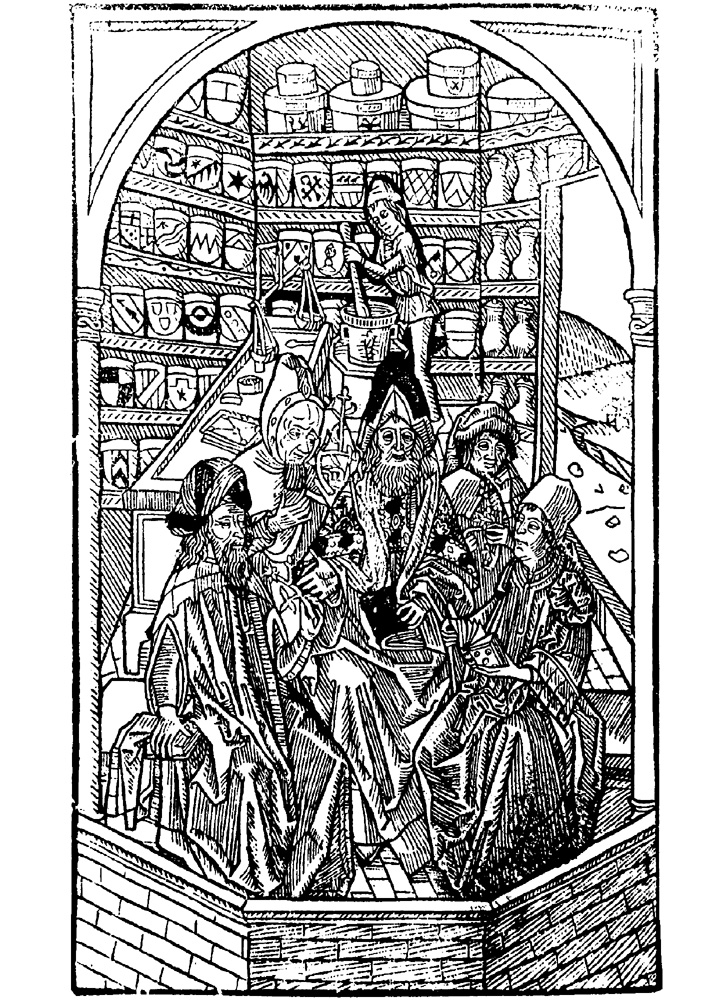
27. German, 1486 [5 June].
[Gart]
Der Gart der Gesundheit ... Augsburg, Johann Schönsperger, 5 June 1486.
2°: a-i8 k-t6 v-z8 A-D8 E6 F8 G-H6 I7 (I7 blank); 258l.; no pagination or foliation. Two column, Gothic letter, 42 lines, with full-page woodcut on the verso of the first leaf (three sitting savants with two attendants in a chemist's shop, behind them an apprentice with a mortar), a smaller cut (a physician with a urine flask and a women), and 394 other text woodcuts of plants and animals.
Very rare. This is Schönsperger's second printing of Der Gart, and has substantial differences from the first, which was simply a copy of the original Schoeffer edition. Here the format has been completely changed by reducing the size of the illustrations to fit onto double-columned pages. That practice not only effected a saving in paper costs, but also resulted in a book of a much handier size. So successful was this adaptation that Schönsperger issued it eight times in all between 1486 and 1502.
Ten new woodcuts were added to the book, and one, Bone from a Deer's Heart, was redesigned, while both the frontispiece and the heading for the Book of Urines were altered, the latter only slightly. In the case of the frontispiece Schönsperger reduced the number of physicians shown to only five, and placed them inside an apothecary's shop where an assistant was preparing herbs, rather than in the garden setting that they had originally inhabited.
The woodcuts of this edition possess a high degree of artistry and some features of note. The appearance of silver, for instance, has been cleverly counterfeited by the use of powdered tin, and is still untarnished after nearly 500 years. And in the image of the gourd, Cucurbit, the typical white flower is portrayed accurately by reserving a blank space for it against a green leaf, a detail that demonstrates to perfection the quality of medieval craftsmanship.
Bibliographical references: Choulant, Graphische Incunabeln, 1858: p. 58, no. 6. • Goff: G-100. • Hain, Repertorium Bibliographicum, 1826-38: no. 8951*. • IGI: no. 4906. • Klebs, Incunabula Scientifica, 1938: no. 507.5. • Klebs, Herbals of the Fifteenth Century, 1917-8: p. 44, no. 3. • Klebs, Catalogue of Early Herbals, 1925: no. 24. • Nissen (BBI): no. 2268. • NUC: 255, 431-4 [NH 0533415]. • Pritzel, Thesaurus Literaturæ Botanicæ, 1871-3: no. 10826. • Schreiber, Kräuterbücher, 1924: xvi-xvii. • Schreiber, Manuel de la Gravure, 1893-1911: 5, no. 4335. • Sudhoff, Bibliographia Paracelsica, 1894: no. 69.
28. German, 1485/1486.
[Gart]
Der Gart der Gesundheit ... Strassburg, Johann (Reinhard) Grüninger, 1485/1486.
2°: a-z8 A-C8 [1-28] (the last two quires unsigned; 2/8 blank); 224l.; no pagination or foliation. Two column, Gothic letter, 43 lines, capital spaces. Full-page woodcut at the beginning (three savants sitting, attended by nine others), smaller cut (physician and women), 384 text cuts of plants and animals. Page size: 207 x 189 mm.
Contents: a1r, Woodcut.; a2v, Blank.; a2r, "[O ]Fft vnd | vil habe | ich by mir selbst | betracht dy wū | dersam werck | des schöpfers [old aux]' | natuer wie er am anbeginde dē hy- | mel hat beschaffen vn gezyeret mit | schönen leuchtendē steren ..."; C7v (=207v), column 1, part 6: "Hie nach volget das | funffte teyl vnnd das lest di[old SZ] bůchs. | vnd ist ein register behende zu finden | von allen krancgheyten der menschē ..."; 2/5r (=221r), column 2: "Di[old SZ] sint die capitelder | kruter nach ordenung des alphabets ..."; 2/8v (=227v), End: "Zucarum zucker. Capitulū. ccccxxxv."
Very rare. Schoeffer's Der Gart inspired a second plagiarism of the original with the issuance of Johann Grüninger's edition at Strassburg. Although it bears no date it is virtually certain that it was published in 1486 and almost at the same time as the Augsburg version by Schonsperger. Because of the date's omission, controversy about priority of publication between these two plagiarisms has continued to the present. Since Schodgsperger had already issued an exact copy of Der Gart in 1485 it is entirely possible that his previous familiarity with the work gave him a slight edge in beating out Grüninger to the bookstalls. As Arnold Klebs, the noted bibliographer, has stated elsewhere, the notion of a more economical format may very well have occurred to both printers simultaneously out of the natural logic flowing from their own experience. But only one observation can be made with certainty, namely, that while both copied Schoeffer neither copied the original cuts of each other.
Grüninger added only five woodcuts of his own, and eliminated but one physician from his adaptation of the frontispiece. What is more, some of his chapter headings are left blank although model illustrations for them were already available. Despite its slightly restricted repertoire of im-ages this edition served as the model for Conrad Dinckmut's publication in 1487, and later for that of Michael Furter at Bash, c. 1490. Through this latter work it influenced the pictorial style of the famous French herbal, Arbolayre, later called he Grant Herbier, and also its English translation, The Grete Herball.
Only one copy of the original edition is known in the United States, and there is no record of any having received contemporary coloring. Yet despite the extreme rarity of the Grüninger original its use by other printers has made its woodcuts the most familiar and widely distributed among the early herbals before those of Brunfels and Fuchs in the sixteenth century.
Johann (Reinhard) Grüninger. (Born: ; Died: Strassburg, Alsace, France, 1529?) German printer. Grüninger's earliest dated book is the Petrus Comestor's Historia Scholastica, completed 28 August 1483.
Bibliographical references: BMC XV: 1, 103 [IB 1508]. • Choulant, Graphische Incunabeln, 1858: p. 56, no. 3. • Copinger, Hain's Repertorium, Supplement, 1898-1902: 2, no. 3178. • Goff: G-99. • Klebs, Incunabula Scientifica, 1938: no. 507.3. • Klebs, Herbals of the Fifteenth Century, 1917-8: p. 45, no. 6. • Klebs, Catalogue of Early Herbals, 1925: no. 25. • Nissen (BBI): no. 2278. • Plesch, Stifung für Botanik Auction, 1975-6: no. 365. • Proctor, Index, 1898-1906: no. 497. • Schramm, Bilderschmuck der Frühdrucke, 1922-36: 20, p. 24. • Schreiber, Kräuterbücher, 1924: xiv-xv. • Schreiber, Manuel de la Gravure, 1893-1911: 5, no. 4334. • Sudhoff, Deutsche Medizinische Inkunabeln, 1908: no. 80 [Prüss]. (Grüninger) ADB. • BMC XV.
29. German, 1486/1487.
[Gart]
Der Gart der Gesundheit ... Basel, Michael Furter about 1486/1487.
2°: 224 leaves (the last blank). Two columns, Gothic letter, 43-44 lines, with full-page woodcut (assembly of 12 physicians, three sitting and nine standing), smaller cut of physician and a woman, and hundreds of text cuts of plants, animals, etc. Floreated initial letters.
Very rare. The only herbal to be printed in Switzerland before 1500 and is nearly an exact reprint of Grüninger's edition of 1485/1486, showing only slight variations of orthography. The cuts with chapter numbers are printed from Grüninger's woodblocks. The full-page woodcut is reversed from Grüninger's edition while the heraldic shield is left blank. Furter adds for the first time floreated woodcut initials, white on black, to most of the chapters. There exists some connection between between this edition and the first French herbal (Arbolayre, Besançon, Metlinger) where the same woodcuts and initials are used.
Bibliographical references: Choulant, Graphische Incunabeln, 1858: p. 57, no. 4. • Goff: G-101. • Hain, Repertorium Bibliographicum, 1826-38: no. 8947*. • Klebs, Incunabula Scientifica, 1938: no. 507.4. • Klebs, Herbals of the Fifteenth Century, 1917-8: p. 46, no. 10. • Klebs, Catalogue of Early Herbals, 1925: no. 28 [dates the work about 1490]. • Nissen (BBI): no. 2281. • NUC: 255, 431-4 [NH 0533416]. • Pritzel, Thesaurus Literaturæ Botanicæ, 1871-3: no. 10822. • Schramm, Bilderschmuck der Frühdrucke, 1922-36: 22, p. 45. • Schreiber, Manuel de la Gravure, 1893-1911: 5, no. 4341.
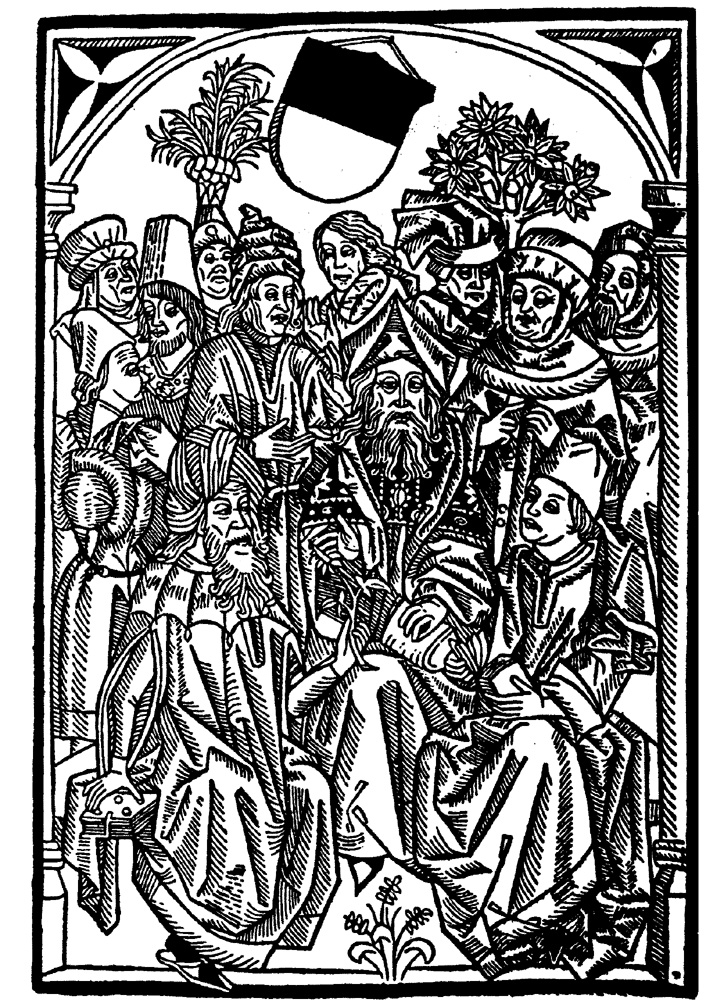
30. German, 1487 [31 March].
[Gart]
Der Gart der Gesundheit ... Ulm, Conrad Dinckmut 1487, Samstag vor Judica (31 March).
2°: a-z8 A-D8 E6 F-G8 H10 (H10 blank); 248l.; no pagination or foliation. Two columns, Gothic letter, 40 lines, with full-page woodcut (assembly of 12 physicians) on the verso of leaf one, smaller woodcut (physician holdin urine-flask, and a woman) on leaf F2, and 393 woodcuts plants, animals, etc. Colophon (H9r): "Gedruckt vnd vollendet seligklichen diser | Herbarius. Durch Conraden Dinckmut zu | Ulm. Am samstag vor Judica. Als man zalt | nach Christi vnnsers herren geburt Tausent | vierhundert vnd sibenundachtizig Jare. | Gottsey lob." Page size: 284 x 202 mm.
Contents: a1r, Blank.; a1v, Woodcut.; a2r, "[O]Fft vn vil hab | ich bey mir se | lbs betrachtet | die wundersammen | werck des schöpffers der naturen | ..."; E6r (=222r), col. 2, line 33: "... in seinem bůch de in | genio sanitatis."; F1r (=223r), "Disz ist das dritteil disz | bůchs. vn ist ain register zefinden | kreüter die do laxiren ..."; (=224r), col. 2: "Disz ist das vierde teil | di[old SZ] bůchs ..."; H9r (=247r), Colophon: "Gedruckt vnd vollendet seligklichen diser | Herbarius. Durch Conraden Dinckmut zu | Vlm. Am samstag vo Iudica. Als man zalt | nach Christi vnnsers herren geburt Tausent | vierhundert vnd sibenundachtzig Iare. | Gott sey lob."
Very rare. The only herbal edition printed by Conrad Dinckmut [see note below]. The woodcuts have a resemblance to the corresponing ones in the Grüninger's edition. Klebs/Becher believes the Grüninger edition to be earlier than Dinckmut's edition because the woodcuts in the later are cruder and appear to have copied from the former and not vice versa. Dinckmut's edition contains also five woodcuts to chapters 37, 50, 142-144 which appear already in Grüninger's edition but are not found in Schoeffer's herbal. Of these chapters, Schönsperger illustrated only chapter 37, 50 and 143, but with cuts different from Grüninger's edition.
The full-page woodcut is likewise copied from the one in Grüninger's edition, reveresed and with slight differences, the shield for instance is not blank, but contains the arms of Ulm. Eight woodcuts (to chapters 38-40, 42, 44, 48-49, and 81) have no corresponding ones in either the Schoeffer or Grüninger editions, and are instead copied from Schönsperger.
Dinckmut's books are all very rare and in great demand by collectors.
Conrad Dinckmut. (Born: ; Died: ) German printer. Dinckmut seems to have begun his career as a printer around 1482, when he produced at least four books, but he is listed as a `Buchdrucker' in the Ulm rate-lists of 1476, and a calendar for 1478, which is in his type and presumed to have been printed by him. He continued to print at Ulm through 1496. He left the city in 1499.
Bibliographical references: BL [IB 9359]. • BMC XV: 2, 535-6 [IB 9359; imperfect copy]. • Choulant, Graphische Incunabeln, 1858: p. 58-9, no. 8. • Goff: G-103. • Hain, Repertorium Bibliographicum, 1826-38: no. 8952*. • Hunt Botanical Catalog: no. 6. • Klebs, Incunabula Scientifica, 1938: no. 507.7. • Klebs, Herbals of the Fifteenth Century, 1917-8: p. 45, no. 5. • Klebs, Catalogue of Early Herbals, 1925: no. 26. • Nissen (BBI): no. 2280. • Pritzel, Thesaurus Literaturæ Botanicæ, 1871-3: no. 10827. • Schramm, Bilderschmuck der Frühdrucke, 1922-36: 6, nos. 178-573. • Schreiber, Manuel de la Gravure, 1893-1911: 5, no. 4338. • Sudhoff, Deutsche Medizinische Inkunabeln, 1908: no. 71. (Dinckmut) BMC XV.
31. German, 1487 [7 March].
[Gart]
Der Gart der Gesundheit ... Augsburg, Johann Schönsperger, 7 March 1487.
2°: 258l. Very scarce.
Bibliographical references: Choulant, Graphische Incunabeln, 1858: p. 58, no. 7. • Goff: G-102. • Hain, Repertorium Bibliographicum, 1826-38: no. 8950. • Klebs, Incunabula Scientifica, 1938: no. 507.6. • Klebs, Herbals of the Fifteenth Century, 1917-8: p. 44, no. 4. • Nissen (BBI): no. 2269. • NUC: 255, 431-4 [NG 0533417]. • Schreiber, Manuel de la Gravure, 1893-1911: no. 4337. • Sudhoff, Deutsche Medizinische Inkunabeln, 1908: no. 70.
32. German, 1488.
[Gart]
Der Gart der Gesundheit ... Augsburg, Johann Schönsperger, ca. 1488.
2°: 258l. Very scarce.
Bibliographical references: Hain, Repertorium Bibliographicum, 1826-38: no. 8945. • Klebs, Herbals of the Fifteenth Century, 1917-8: p. 45, no. 7. • Nissen (BBI): no. 2270. • Sudhoff, Deutsche Medizinische Inkunabeln, 1908: no. 77.
33. German, 1488 [15 December].
[Gart]
Herbarius zů teůt | sch vnd von aller | handt kreůteren.
2°: [*]4 a-z8 A-D8 E6 F8 G-H6 I8 (I8 blank); 262l.; no pagination or foliation. Two columns, Gothic letter, 42 lines, with full-page woodcut on the recto of leaf 5 (five physicians in a chemist's shop, behind them an apprentice with a mortar) and hundreds of text cuts of plants and animals. Page size: 256 x 187 mm.
Contents: [*]1r, Title.; I7v, Colophon: "[Dark C] Gedruckt vnd volendet dÿserlichen statt | zů Augspurg am montag vor | san Thomas tag. Anno. M. cccc | vnd in dem. lxxxviij. jare."
Very rare. Printed in Augsburg by Johann Schönsperger on the 15 December 1488. This edition shows for the first time a separate title, followed by an alphabetical table of German names of plants, which is a new addition. The text begins on the recto of leaf 8. The full-page woodcut, the woodcut before the urine tract (physican and woman) and the woodcuts in the text are the same as in Schönsperger's second edition of 1486.
Bibliographical references: BMC XV: 2, 366 [IB 6303; imperfect copy]. • Choulant, Graphische Incunabeln, 1858: p. 59, no. 10. • Goff: G-104. • Hain, Repertorium Bibliographicum, 1826-38: HC 8953* [includes H 8945*]. • Klebs, Incunabula Scientifica, 1938: no. 507.8. • Klebs, Herbals of the Fifteenth Century, 1917-8: p. 45-6, no. 8. • Klebs, Catalogue of Early Herbals, 1925: no. 27. • Nissen (BBI): no. 2271. • NUC: 255, 431-4 [NH 0533418]. • Pritzel, Thesaurus Literaturæ Botanicæ, 1871-3: no. 10828. • Proctor, Index, 1898-1906: no. 1770. • Schreiber, Kräuterbücher, 1924: 5, 4340 [includes no. 4339]. • Sudhoff, Deutsche Medizinische Inkunabeln, 1908: no. 72.
34. German, 1489.
[Gart]
Der Gart der Gesundheit ... Strassburg, Johann Grüninger um 1489.
2°: 224l. Very scarce.
Bibliographical references: Choulant, Graphische Incunabeln, 1858: p. 57, no. 5. • Goff: G-108 [n.d.]. • Hain, Repertorium Bibliographicum, 1826-38: no. 8946*. • Hunt Botanical Catalog: no. 301 [about 1500]. • Klebs, Incunabula Scientifica, 1938: no. 507.9 [1489]. • Klebs, Herbals of the Fifteenth Century, 1917-8: p. 46, no. 9. • Nissen (BBI): no. 2279. • Schramm, Bilderschmuck der Frühdrucke, 1922-36: 20, nos. 661-940. • Schreiber, Manuel de la Gravure, 1893-1911: no. 4336 [Anshelm?, about 1487]. • Sudhoff, Deutsche Medizinische Inkunabeln, 1908: no. 78.
35. German, 1493 [13 August].
[Gart]
Herbarius zu teüt | sche vnd von alter | handt kreüuteren.
2°: 260 leaves (the last two blank). Two columns, Gothic letter, 42 lines, with hundreds of text woodcuts of plants, animals, etc.
Very rare. Printed in Augsburg by Johann Schönsperger on the 13 August 1493. Klebs/Becher: "There exist two different Schönsperger editions, both issued, according to their colophons, on the "Afftermontag nach Tyburcij," 1493 (=13 August), which are separately quoted by Sudhoff and Klebs. Hains 8954 mentions the variant in a note. Klebs rants this edition after the other variant. It represents, according to Klebs and Sudhoff, a new issue containing unchanged only the make-up of the signatures: d, h, k, p-J."
Bibliographical references: Choulant, Graphische Incunabeln, 1858: p. 61, no. 13. • Goff: G-105. • Hain, Repertorium Bibliographicum, 1826-38: no. 8954*. • IGI: no. 4907. • Klebs, Incunabula Scientifica, 1938: no. 507.11. • Klebs, Herbals of the Fifteenth Century, 1917-8: p. 47-8, no. 13. • Klebs, Catalogue of Early Herbals, 1925: no. 29. • Nissen (BBI): no. 2272. • NUC: 255, 431-4 [NH 0533419]. • Schreiber, Manuel de la Gravure, 1893-1911: 5, no. 4342. • Sudhoff, Deutsche Medizinische Inkunabeln, 1908: no. 73.
36. German, 1493 [Variant edition].
[Gart]
Herbarius zu teütsche/ vnnd von allerhandt kreüteren ... Augsburg, Johann Schönsperger, 13 August 1493.
2°: 262l. Two columns, Gothic letter, 42 lines, with hundreds of text woodcuts of plants, animals, etc.
Very rare. A variant edition of the previous title. Klebs/Becher: "It uses a somewhat different type with many variations in orthography, especially in the use of i and y. The chapter headings are printed with another Gothic type, considerably smaller than the previous edition, in which the headings always begin with a large initial, while most of the headings of this edition begin with small letters. The misprint at the beginning of the preface: `... weercke' seems to be found only in this edition."
Bibliographical references: Choulant, Graphische Incunabeln, 1858: p. 61, no. 13. • Goff: G-105. • Hain, Repertorium Bibliographicum, 1826-38: H 8954n. • Klebs, Herbals of the Fifteenth Century, 1917-8: p. 47, no. 12. • Klebs, Catalogue of Early Herbals, 1925: no. 30. • Nissen (BBI): no. 2273. • Sudhoff, Deutsche Medizinische Inkunabeln, 1908: no. 74.
37. German, 1496 [10 May].
[Gart]
Herbarius zu teütsche | vnnd von allerhandt kreüteren.
2°: 262 leaves (the last two blank). Two columns, Gothic letter, 39 lines, with full-page woodcut (group of five savants in pharmacy, behind them an apprentice), and hundreds of text woodcuts of plants, animals, etc.
Very rare. Printed in Augsburg by Johann Schönsperger on the 10 May 1496. Reprint of Schönsperger's second edition of 1486 with the same woodcuts, to which several small ones are added. Initial letter at the beginning.
Bibliographical references: Choulant, Graphische Incunabeln, 1858: p. 60, no. 12. • Goff: G-106. • Hain, Repertorium Bibliographicum, 1826-38: no. 8955*. • Klebs, Herbals of the Fifteenth Century, 1917-8: p. 48, no. 14. • Klebs, Catalogue of Early Herbals, 1925: no. 31. • Nissen (BBI): no. 2274. • NUC: 255, 431-4 [NH 0533421]. • Pritzel, Thesaurus Literaturæ Botanicæ, 1871-3: no. 10830. • Schreiber, Manuel de la Gravure, 1893-1911: 5, no. 4343. • Sudhoff, Deutsche Medizinische Inkunabeln, 1908: no. 75.
38. German, 1499 [13 May].
[Gart]
Herbarius zu teütsche/ vnnd von allerhandt kreüteren. ... Augsburg, Johann Schönsperger, 13 May 1499.
2°: 262l. Two columns, Gothic letter, 39 lines, with large woodcut on the title (apothecary and physician in a chemist's shop), two full-page woodcuts (1: magister sitting on an elaborate arm chair and four pupils; 2: three savants, sitting in a pharmacy, attended by two others, behind them an apprentice), hundreds of text woodcuts of plants, animals, etc.
Very rare. This edition of which only a few examples are known shows the same make-up of text (except the first five leaves) as Schönsperger's 1496 edition. The title page woodcut and the full-page woodcut first occur in Brunschwig's Chirurgia, Strassburg, Grüninger, 1497. After the title are four leaves being a table of German plants of names.
Bibliographical references: Choulant, Graphische Incunabeln, 1858: p. 60-1, no. 13. • Goff: G-107. • Hain, Repertorium Bibliographicum, 1826-38: H 8956. • Klebs, Incunabula Scientifica, 1938: no. 507.13. • Klebs, Herbals of the Fifteenth Century, 1917-8: p. 48, no. 15. • Klebs, Catalogue of Early Herbals, 1925: no. 32. • Nissen (BBI): no. 2275. • NUC: 255, 431-4 [NH 0533423]. • Schreiber, Manuel de la Gravure, 1893-1911: 5, no. 4344. • Sudhoff, Deutsche Medizinische Inkunabeln, 1908: no. 76.
39. German, 1502.
[Gart]
Herbarius zu teütsche/ vnnd von allerhandt kreüteren. ... Augsburg, Hanns Schönsperger, 1502.
2°: 258?l. Colophon (J7v): Gedruckt vnd seligklich volendet diser Herbarius durch Hannsen Schoensperger. In der Keiserlichen Satt [!] Augspurg. An sant Clementen tag des Heyligen Pabsts. Nach Cristi vnnsers Herren geburt Funfftzehen-hundert vun zwey iar. Gott sey lob. Very scarce.
Bibliographical references: Choulant, Graphische Incunabeln, 1858: no. 13 [Anmerkung]. • Nissen (BBI): no. 2276. • NUC: 255, 431-4 [NH 0533424]. • Pritzel, Thesaurus Literaturæ Botanicæ, 1871-3: no. 11893.
40. German, 1507-9.
[Gart]
[Part I:] In disem Bůch ist der Herbary: oder kreüterbuch, genant der gart der gesuntheit, mit merern figuresn vnd registern ... [Strassburg, Johann Prüss, 1507].
[Part II: Hortus Sanitatis translated into German] In diesem Bůch ist der Gart der gesuntheit (zu latin Ortus sanitatis) in vier theyl getheylet. Mit seinen register der artznyen ... [Strassburg, Johann Prüss, 1509].
2 parts in one volume. [Part 1: 1507] 2°: a-z6 A-H6 Aa-Dd6 (Dd6 blank); 204l.; [6], clxxxii, [17]l., errors in foliation. Gothic letter, 5 nearly full-page woodcuts (1, on the title: apothecary with physician; 2/3, patient in bed and three attending physicians (repeated); 3: human skeleton; 4: chemist cooking, and physician with vessel), and many smaller text cuts of plants and genre pictures. [Part 2: 1509] 2°: a-o6 A-O6 (O6 blank); 174l.; no pagination or foliation. Two columns, Gothic letter, with three large woodcuts (1/2: patient in bed and three attending physicians (repeated); 3: human skeleton), over 500 smaller text cuts of animasl, fishes, birds and precious stones. Four of these smaller cuts are on the title page.
Very rare. A compilation of the German Gart with parts of the Latin Hortus Sanitatis translated into German. The first part is a reprint of the German Gart der Gesundheit. The second part is the first German translation of the Latin Hortus Sanitatis, comprising the four sections dealing with animals, fishes, birds and precious stones. The portion on the plants is not translated as that material is covered in the first part. The greater part of the smaller woodcuts are derived form Prüss' fifteenth century editions.
Bibliographical references: Choulant, Graphische Incunabeln, 1858: p. 66-7, no. 21. • Klebs, Catalogue of Early Herbals, 1925: no. 33. • Kristeller, Italienische Buchdruckerzeichen, 1893: nos. 61 & 64. • Nissen (BBI): no. 2282. • NUC: 255, 431-4 [NH 0533425]. • Pritzel, Thesaurus Literaturæ Botanicæ, 1871-3: no. 10831. • Schreiber, Kräuterbücher, 1924: xxviii.
41. German, 1508.
[Gart]
Herbarius zu teütsche vnd von allerhand kreüter ... Augsburg, Hans Otmar für Johann Reynmann, 1508.
2°: 240 leaves (the last blank). Gothic letter, with large woodcut on the title page (apothecary and physician in a chemist's shop), two full-page woodcuts (magister and four pupils; three savants in a pharmacy, attended by two others, behind them an apprentice), very many woodcuts of plants, animals, precious stones in the text. Initial letter at the beginning.
Very rare. Only a few copies of this edition are known. It is printed by Hanns Otmar [see note below] and is a reprint of the preceding editions of Schönsperger, 1496 and 1499, with only the orthography showing variations. Otmar has used the same page make-up and the same woodcuts and types as Schönsperger. However, by introducing broader columns, he reduces the contents to 239 leaves. A curious woodcut at the end shows Christ (or Godfather?) with the holy lamb, and the convocation of the Last Judgement. (Klebs/Becher)
Hanns Otmar. (Born: Reutlingen, Germany, ; Died: Augsburg, Germany?, ) German printer. Between 1479 and 1501, Otmar printed many books at Reutlingen and Tübingen, but in 1501 reestablished himself in Augsburg, where he published his first title from this, his third press, in 1502.
Bibliographical references: Choulant, Graphische Incunabeln, 1858: p. 67, no. 22. • Klebs, Catalogue of Early Herbals, 1925: no. 34. • Nissen (BBI): no. 2277. (Otmar) Klebs, Catalogue of Early Herbals, 1925: no. 34.
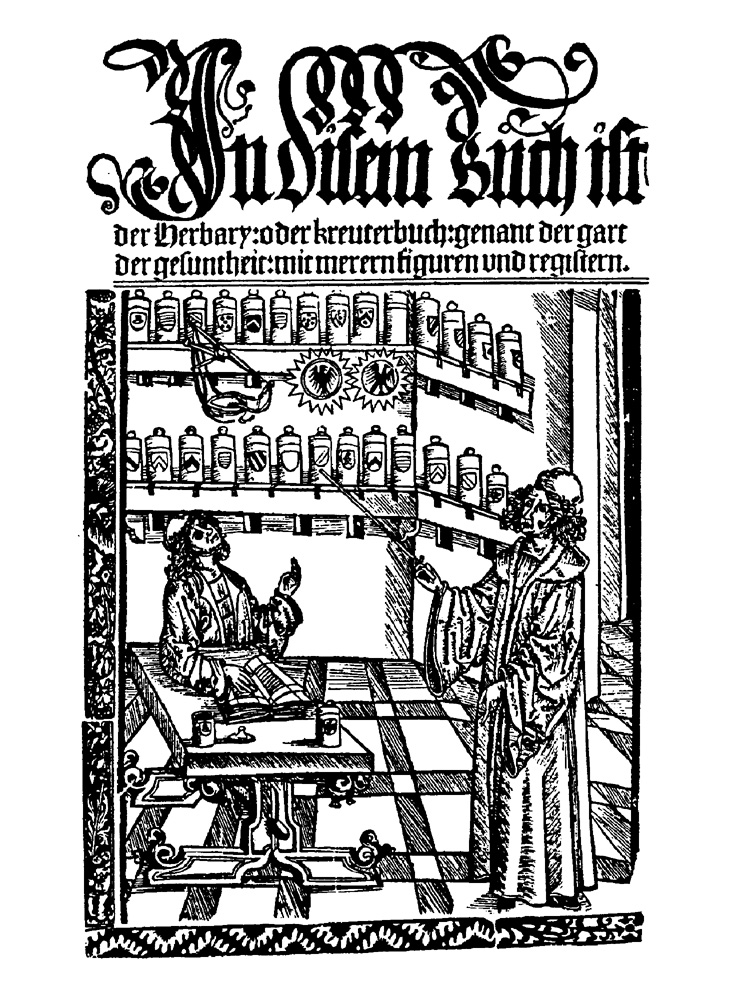
42. German, 1515.
[Gart]
In disem bůch ist | der Herbary: oder kreuterbuch: genant der gart | der gesuntheit: mit merern figuren vnd registern. | [Woodcut showing two figures inside an apothecary shop].
2°: a-z6 A-E6 Aa2 Bb8 Cc6; 184l.; [6]l., leaves I-CLX, [1] leaf (skelton), 17l (index), 5 large woodcuts (1: Apthecary's shop with two figures; 2/3: patient in bed, with three physicans (repeated); 4: full-page skeleton; 5: chemist cooking and a physician with vessel), and 436 text woodcuts of plants, animals, precious stones and minerals. Printer's mark on the last leaf. Colophon: "Getruckt ... durch Renatum Beck / Büchtrucker züm Thierfasten. In dem Jar da man zalt nach der geburt Christi/Tusent/fünff-hundert vnd.xv."
Very scarce. This is the first edition of Gart der Gesundheit to be printed by Renatus Beck [see note below]. In appearance it mimics the incunabula editions (an almost exact copy of Prüss 1507 edition), using to a large extent the old woodcuts, with only a few new ones to replace lost wood blocks.
Renatus Beck. (Born: köln, Germany, ; Died: Strasbourg, Alsace, France, 1521/2) German printer. Beck became a citizen of Strasbourg in 1511. He established his press there as well.
Bibliographical references: Choulant, Graphische Incunabeln, 1858: p. 67-8, no. 23 [wrong collation]. • Klebs, Catalogue of Early Herbals, 1925: no. 35. • Kristeller, Italienische Buchdruckerzeichen, 1893: no. 568. • Nissen (BBI): no. 2283. • NUC: 255, 431-4 [NH 0533426]. • Plesch, Stifung für Botanik Auction, 1975-6: no. 366. • Pritzel, Thesaurus Literaturæ Botanicæ, 1871-3: no. 10831. • Sudhoff, Deutsche Medizinische Inkunabeln, 1908: no. 81a. (Beck) ADB. • Benzing, Buchdrucker des 16 und 17 Jahrhunderts, 1982: p. 440. • DBA: I 70, 51. • Ritter, F., "?? Reinhart and Balthasar Beck ??," Gutenberg-Jahrbuch, 26 (1951), 101-9. • WBI.
43. German, 1521.
[Gart]
In disem Bůch ist | der Herbari: oder kreuterbůch: ge | nant der gart der sesuntheit: mit me | reren Figuren und Registeren. | [woodcut].
2°: a-z8 A-D6 E-F8 G6; 184l.; [6], CLX, [18]l. Two columns, Gothic letter, with 4 large woodcuts (1. Full-page woodcut of skeleton on E5r; 2. large woodcut of apprentice stirring a cauldron and a physician standing by a flask on E5v; 3. Small woodcut of the Annunciation on E6v; 4. Small cut of physician at desk with flask and woman with hamper on E7r; 5. Full-page woodcut of the Saints Cosmos and Damien on F1r; 6. Large woodcut of man in bed attended by 3 physicians on F1v), and over 400 text cuts of plants, animals, etc. Colophon (G6r): "Getruckt vnd flysziglichen volendet durch Rena | tum Beck. In dem Jor do man zalt nach | der geburt Christi, Tusent, fünff hundert vnd. xxi."
Very rare. Second edition printed by Renatus Beck. The woodcuts are in most cases identical to the 1515 issue. Two woodcuts of plants appear on the title page.
Bibliographical references: Choulant, Graphische Incunabeln, 1858: p. 68, no. 24. • Hunt Botanical Catalog: no. 21. • Klebs, Catalogue of Early Herbals, 1925: no. 36. • Kristeller, Italienische Buchdruckerzeichen, 1893: no. 571 [not seen]. • Nissen (BBI): no. 2285. • NUC: 255, 431-4 [NH 0533428]. • Pritzel, Thesaurus Literaturæ Botanicæ, 1871-3: no. 10831.
44. German, 1527.
[Gart]
Herbarius. Kreüter buch von neüwem mit höchstem fleisß durchsucht und gebessert. sampt drey neüwen Registern. Getruckt zu Straszburg am Holtzmarckt, durch Balthassar Beck. Nach dem jar der geburt Christi des herren. M.D.XXVij.
2°: Aa-Cc6 a-z6 A-E6; 185l.; [18], 162, [5]l. Two columns, Gothic type.
Very scarce. Balthasar Beck's [see note below] first printing of Der Gart.
Balthasar Beck. (Born: Kirchheim an der Teck, Germany, ; Died: Strasbourg, Alsace, France, 1551) German printer. Need Biography.
Bibliographical references: Choulant, Graphische Incunabeln, 1858: p. 68-9, no. 25. • Nissen (BBI): no. 2286. (Beck) Benzing, Buchdrucker des 16 und 17 Jahrhunderts, 1982. • DBA: II 84, 204. • NDB. • Ritter, F., "?? Reinhart and Balthasar Beck ??," Gutenberg-Jahrbuch, 26 (1951), 101-9. • WBI.
45. German, 1528.
[Gart]
Kreüterbuch oder Herbarius ... Strassburg, Balthasar Beck, 1528.
2°: 186l. Gothic letter. Fine historiated woodcut border around the title (on the sides figures representing Galienus and Aescolapius) and 380 text woodcuts of plants, animals, etc.
Rare. Second German edition of the Gart printed by Balthasar Beck. With the exception of the title border, nealy all the woodcuts are derived from the preceding editions of Renatus Beck.
Bibliographical references: Klebs, Catalogue of Early Herbals, 1925: no. 37. • Nissen (BBI): no. 2287. • Pritzel, Thesaurus Literaturæ Botanicæ, 1871-3: no. 10831.
46. German, 1529.
[Gart]
Gart der Gesuntheit. Zu Latin Ortus sanitatis. Von allerley Thieren, Voglen, Vischen oder Morwundern, und edlem Gstein ... mit hochstem Fleissz durch sucht, corrigiert, und gebessert. Item ein neuw Register ... [Strassburg, Balthasser Beck, 1529].
2°: 144l.; no pagination or foliation. Two columns, Gothic type, 46 lines. 398 woodcuts. Very rare.
Bibliographical references: NUC: 255, 431-4 [NH 0533430].
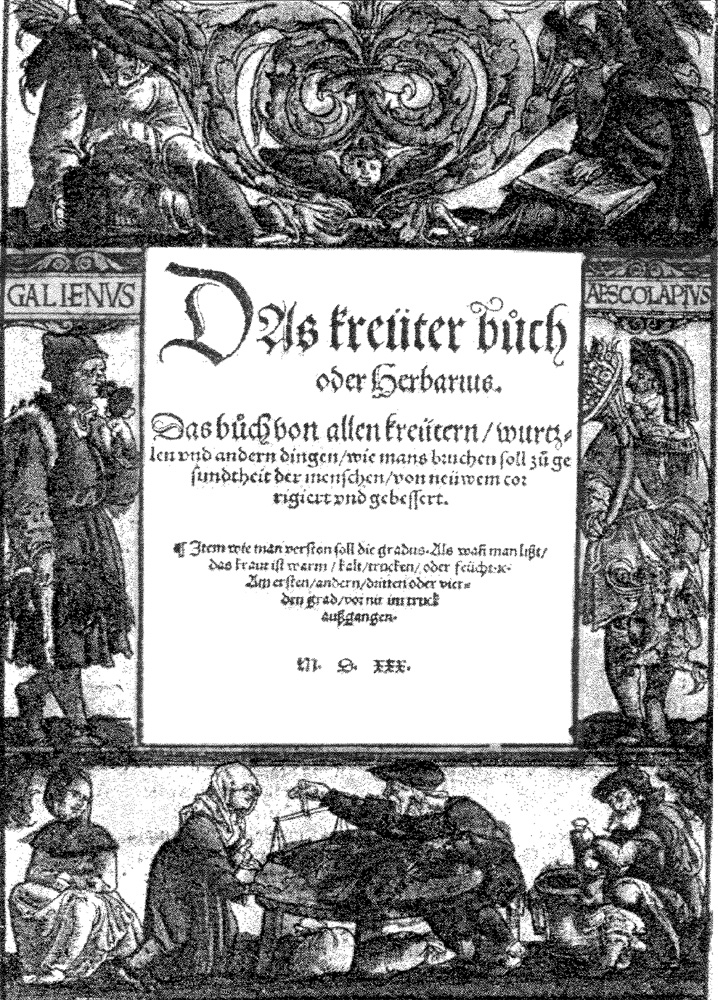
47. German, 1530.
[Gart]
[Within an elaborate woodcut border:] Das kreüter bůch | oder Herbarius. | Das bůch von allen kreütern/ wurcz= | len vnd andern dingen/ wie mans bruchen soll zů ge | sundtheit der menschen/ von neüwem cor | rigiert vnd gebessert. | ¶ Item wie man versten soll die gradus. Als wah man ltßt/ | das kraut ist warm/ kalt/ trocken/ oder feüchter. |
Am ersten/ andern dritten oder vier= | den grad/ vor mit im truck | außgangen. | M. D. XXX.
2°: 186l.; [18], 162, [4]l. Gothic letter. Title surrounded by a fine woodcut border, and about 380 text woodcuts of plants, animals, etc.
Very scarce. Third edition printed by Balthasar Beck. The title border and woodcuts are identical to B. Beck's previous editions.
Bibliographical references: Choulant, Graphische Incunabeln, 1858: p. 68-9, no. 25n. • Klebs, Catalogue of Early Herbals, 1925: no. 38. • Kristeller, Italienische Buchdruckerzeichen, 1893: no. 575. • Nissen (BBI): no. 2288.
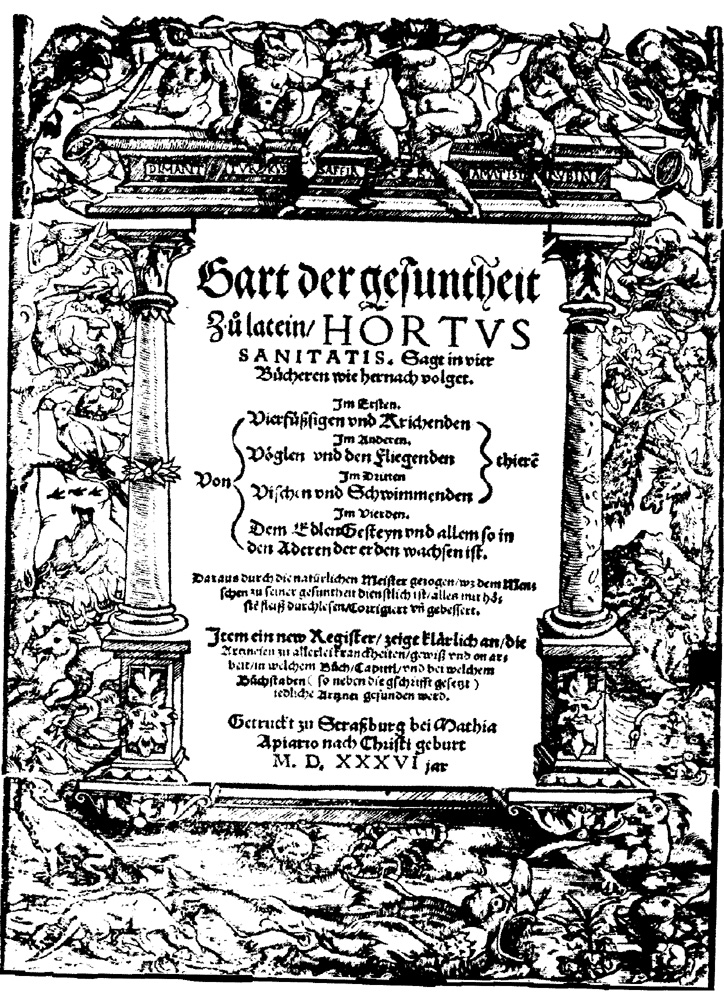
48. German, 1536.
[Gart]
[Within a woodcut frame composed of plants, birds, animals and demons:]
Gart der gesuntheit | Zů latein/ Hortvs | Sanitatis. Sagt in vier | bůcheren wie hernach volget. | Im Ersten. | [The next 8 lines braced with the word "Von" to the left (the top 4 lines braced on the right with "theirē": Vierfüßsigen vnd Krichenden [thierē]. | In Anderen. | Vöglen vnd den Fliegenden [thierē]. | Im Dritten. | Vischen vnd Schwimmenden [thierē]. | Im Vierden. | Dem Ddlen Gesteyn vnd allem so in | den Aderen [!] der erden wachsen ist. | Daraus durch die natürlichen Meister gezogen/ wz dem Men= | schen zu seiner gesuntheit dienstlich ist/ alles mit hö= | stē fleiß durchlesen/ Corrigiert vn gebessert. | Item ein new Register/ zeigt Klärlich an/ die | Artznesen zu allerlei kranckheiten/ gewiß vnd on ar= | beit/ in welchem Büch/ Captitti/ vnd bei welchem | Büchstaben (so neben die gschrifft [!] gesetzt) | iedliche Artznei gefunden werd. | Getruckt zu Straßburg bei Mathia | Apiario nach Christi geburt | M. D. XXXVI jar.
4°: [6], CXLIIl. Title in red and black with ornamental border. Rare.
Bibliographical references: Nissen (BBI): no. 2371. • NUC: 255, 431-4 [NH 0533433].
Low German Dialect editions
49. German, 1492 [Low German Dialect].
[Gart]
Gaerde der suntheit ... Lübeck, Steffen Arndes, 1492.
2°: 324 leaves, 41 lines, with a full page woodcut on leaf 305 (a physician holding a urine flask against the sun, to the right a male cripple with hamper), and 519 text woodcuts of plants, animals, precious stones, etc. Woodcut initial letters.
Very rare. Printed by Steffen Arndes [see note below], this is a remarkable herbal for several reasons: it is among the earliest and most extensive of books to be printed in the Low German dialect, it possesses splendid initial letters in ornamental Gothic style, and it blends the texts from Schoeffer's Der Gart and Meydenbach's Hortus Sanitatis.
About two-thirds of the work is drawn from Der Gart, and the remainder from the Hortus Sanitatis. It is a Low German version of Schoeffer's original text, greatly augmented by translations added from the Latin Hortus. The "van den edelen stenen" (de lapidibus), with 146 chapters has been adapted from Meydenbach's Hortus and 107 new chapters on vegetable and animal subjects have been added to the main part, making a total of 688 chapters (except the tract on uroscopy). Thus, this is the edition with the greatest number of plant descriptions. However, the order of the text and the placement of the images differ considerably from both of its sources. There are numerous duplications of individual chapters, and frequent use of uncommon or exotic synonyms to conceal the padding, a fairly common practice at the time. In general its illustrations are of a high caliber, sometimes improving upon the originals, yet not quite equal to Schreiber's claim that they "surpass by far all the High German editions." 370 of the text cuts are exact copies of Schoeffer's illustrations, while other illustrations are derived from Meydenbach's Hortus.
Klebs/Becher: "The translation of the whole work including that of the Latin tract on precious stones, is very exact, sometimes two Low German names are added to the Latin names of herbs; the aspect of the compilation is very harmonious, indeed."
Steffen Arndes. (Born: Mayence, Germany, ; Died: Lübeck, Germany, 1519) German printer. Arndes was the greatest of the Low German printers, having published in 1494 the famous Lübeck bible. He began his printing activities in Perugia, then afterwards at Schleswig and finally in 1487 he established himself in Lübeck. He was succeeded by his son, Hanns.
Bibliographical references: Choulant, Graphische Incunabeln, 1858: p. 70-1, no. 29. • Goff: G-109. • Hain, Repertorium Bibliographicum, 1826-38: HR 8957. • Kinderling, Geschichte der niedersächsischen Sprache. ????: p. 356. • Klebs, Incunabula Scientifica, 1938: no. 507.10. • Klebs, Herbals of the Fifteenth Century, 1917-8: p. 46-7, no. 11. • Klebs, Catalogue of Early Herbals, 1925: no. 39 [wrong leave count]. • NUC: 255, 431-4 [NH 0533439]. • Oates, Cambridge 15th Century Books, 1954: no. 1192. • Pritzel, Thesaurus Literaturæ Botanicæ, 1871-3: no. 10832. • Scheller, K.F.A., Bücherkunde der sassisch-niederdeutschen Sprache, hauptsächlich nach den Schriftdenkmälern der Herzogl. Bibliothek zu Wolfenbüttel. Braunschweig, Gedrukkt im Fürstl. Waisenhause, 1826. [i]-xvi, [1]-528 p: p. 99, no. 453. • Schramm, Bilderschmuck der Frühdrucke, 1922-36: 11, p. 12, nos. 224-744. • Schreiber, Kräuterbücher, 1924: xxv-xxvi. • Schreiber, Manuel de la Gravure, 1893-1911: no. 4345. • Sudhoff, Deutsche Medizinische Inkunabeln, 1908: no. 81 [wrong leave count]. (Arndes) BMC XV. • Voulliéme, Deutsche Drucker, 1922: 95-6.
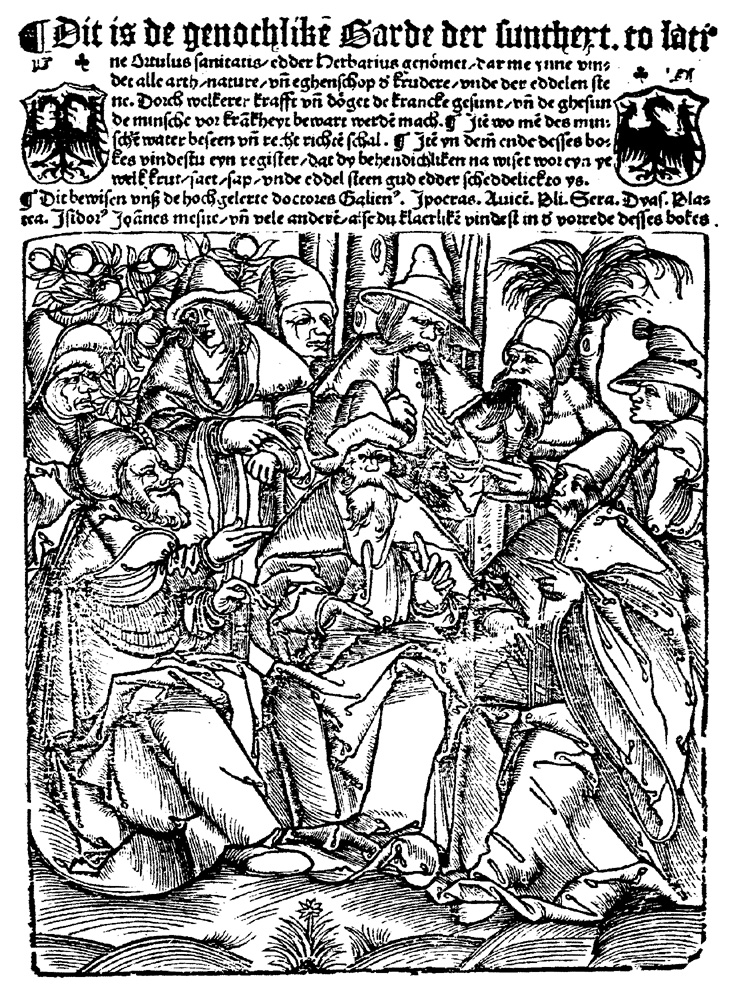
50. German, 1520 [Low German Dialect].
[Gart]
[Dark C] Dit is de genochlikē Garde der suntheyt. to lati- | ne Ortulus sanitatis/ edder Herbarius genömer/ dar me inne vn= | det alle arth/ nature/ vn eghenschop [old aux]' krudere/ vnde der eddelen ste | ne. Dorch weikerer Krafft vn döget de Krancke gesunt/ vn de ghesun | de minsche vor Kraākheyt bewart werdē mach. ¶ Itē wo mē des min= | sch'ē water beseen vn recht richtē schal. ¶ Itē vn dem ende desses bo= | kes vindestu eyn register/ dat dy behendich'liken na wtset wor eyn ye | welt krut/ saet/ sap/ vnde eddel steen gud edder scheddelick so ys. | ¶ Dit bewiser vnß de hoch gelerte doctores salien9. Ipocara. Auicē. Pli. Sera. Dyas. Bla= | tea. Isidor9 Ioānes mesne/ vn vele anderē/ also du Klaerlikē vin dest in [old aux]' vorrede desses bokes. | [Large woodcut showing central savant surrounded by eight disciples].
2°: a6 b8 c-e6 f-g4 h-i6 k5 l-q6 r4 s-t6 v6 x-z6 &6 cō6 aa-gg6 hh5 ii6 kk-rr6 [OldR,OldR]4 [OldS,OldS]6 ss-tt6 vv4 xx4 yy-zz6 A-B6 C4 D-E6 F4; 322l.; large woodcut on title and 492 text woodcuts.
Rare. Printed in the Low German dialect in Lübeck by Steffen Arndes in 1520. Reprint of the 1492 edition?
Bibliographical references: Choulant, Graphische Incunabeln, 1858: p. 71-2, no. 31. • NUC: 255, 431-4 [NH 0533427].
Dutch editions
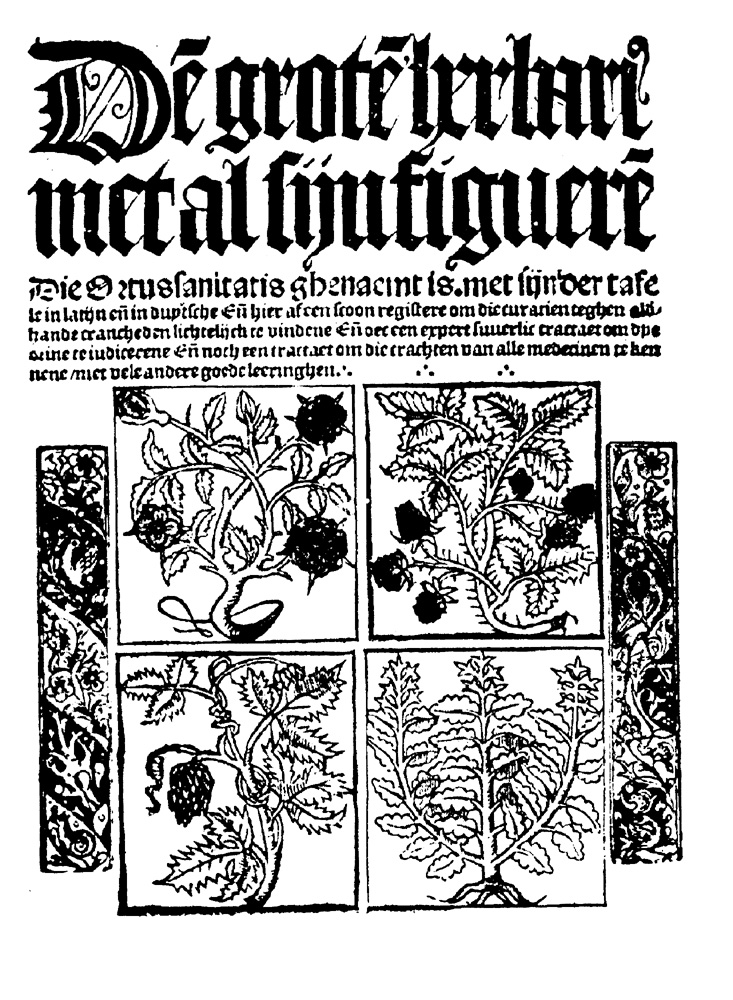
51. Dutch, 1514.
[Gart]
Dē grotē herbari9 | met al sijn figuerē | Die Ortus sanitatis ghensemt is.met sijnder tafe | le in Latijn en in Duytsche En hier aseen scoon registere om die curatien teghen alti= | lz ande crancheden lichtelijch te vindene En oec een expert sunerlic tractaet om vpe | iorine reindirerene En noch een tractaet om die trachten van alle mederinen te hen | nene/ met vele andere goede leeringhen. [ornaments] | [Four small woodcuts arranged in a square with woocut pieces on either side forming a border].
2°: [6], CXC (i.e., CLXXXV), [19]l. Gothic letter. Four small woodcuts on the title page arranged in a square within two vertical borders. One full-page woodcut (human skeleton after Grüninger's cut) and over 400 text woodcuts (several repeated) of plants, animals, genre pictures. Initial letters.
Scarce. Third edition of the Dutch translation of the Gart; the first printed by Claes de Grave. Many of the woodcuts are copied and reduced from the Latin Hortus Santatis, especially Prüss' edition. The cuts of the genre pictures are somewhat finer in detail than their models. (Klebs/Becher) The Dutch version contains an additional treatise Cautelen attributed to Arnaud de Villeneuve.
Bibliographical references: Choulant, Graphische Incunabeln, 1858: p. 73, no. 33. • Klebs, Catalogue of Early Herbals, 1925: no. 40. • Nijhoff & Kronenberg, Nederlandsche Bibliographie: no. 1051. • Nissen (BBI): no. 2289. • NUC: 255, 431-4 [NH 0533434]. • Pritzel, Thesaurus Literaturæ Botanicæ, 1871-3: no. 10834.
52. Dutch, 1526.
[Gart]
Dē grotē herbari9 | met al sijn figuerē | Die Ortus sanitatis genaemt is. om die crachten vā alle cruyden te | wetené metter tafelen in latijn ende in duysche. | [Dark C] Noch een Register om die uracien teghen alderhande cranche- | den lichtelijcte vindene | [Dark C] Noch een expert tractaet. om alle orijnen te iudicerene | [Dark C] Noch een tractaet van den cautelen der orijnen der orijnen van meester Arnol | dus de villa noua. op dat eē medecijn meester niet bedrogē en worde | [Dark C] Noch een tractaet om die operaciē van alle droogherijen en mede | cinen te kennene. Metter Anothomie der menselijcker ghebeentē. | Ende met andere ontellijcke nootsakelijcke leeringhe. | [Dark C] Wedere verdruct ende ghecorrigeert [Maltese Cross] Lof [Maltese Cross] God [Maltese Cross] Van [Maltese Cross] Al [Maltese Cross] | [two woodcuts, side-by-side and a vertical border at the right].
2°: [Maltese Cross]4 a-y6.4 z6 &4 [old con]6 A-H4.6 I4 K4 L6 M4; 188l.; [4], i-Clxiij, [21]l. Two columns, Gothic letter. Two small woodcuts on the title page (one representing a physician with urine flask and a women the other a plant). Full-page woodcut of a human skeleton, and over 400 text woodcuts of plants, animals, etc. Colophon (M4r): [Dark C] Desen boeck is geprint in die vermeer | de ccoopstadt [!] van antwerpē bi mi Claes | die Graue In onser lieuer vrouwē pant | Bi die Camerpoorte Int iaer ons herē | M.CCCCC. ende xxvi Den xviii. daciz | van Iunio | [woodcut].
Extremely rare. Second edition printed in Antwerp by Claes de Grave. The same woodcuts as the preceding edition. According to the Hunt catalog, only four copies of this edition are known.
The first woodcut on the title page shows a man holding a flask, and a woman with a hamper. This cut is repeated on Iir and below the colophon. The second woodcut on the title is of a plant. A full-page woodcut of a skeleton appears on H3v. Throughout the text are small woodcuts of plants, animals, stones and genre scenes.
Bibliographical references: Hunt Botanical Catalog: no. 24. • Klebs, Catalogue of Early Herbals, 1925: no. 41. • Nijhoff & Kronenberg, Nederlandsche Bibliographie: no. 1052. • Nissen (BBI): no. 2290.
53. Dutch, 1532.
[Gart]
Den groten | herbarius | met alden figueren der cruyden ... [Ultrecht?]: Jan van Doesborch, 1532.
2°: {\bf{x}}4 a-z4 &4 [Con]4 A-H4; 196l.; no pagination or foliation. Very scarce.
Bibliographical references: Nissen (BBI): no. 2292. • NUC: 255, 431-4 [NH 0533436].
54. Dutch, 1533.
[Gart]
Den groten herbarius met al sijn figueren der cruyden, om die crachten der cruyden te onderkennen ... Noch eenen experten tractaet om all urinen te iudiceren. Noch eenen tractaet vanden cautelen der urinen van meester Arnoldus de Villa nova ... Noch eenen tractaet om die operacien van alle droogherien ende medicijnen te kennen. Met dye anathomie vanden ghebeente vanden mensche. Moch eenen experten tractaet voer persoonen die op dorpen ende casteelen ... om te maken wondrancken, salven, ende olien ... Item noch eenen ... tractaet van die spaensche pocken [ghescreven door ... Wendelin Hock] ... [Thantwerpen, Claes de Grave] 1533.
4°: [4], clxiii, [31]l. Gothic letter. Title in red and black with a woodcut at the bottom representing a "Garden of Health." Full-page woodcut of a human skeleton and over 400 text woodcuts of plants, animals, etc.
Scarce. Third edition by Claes de Grave, to which is added another treatise, "Den Antidotarius voor Barbiers ende ander, om te maken Saluen, Olien, Plaesteren, Poederen, Slaepdrancken ende Wondrancken." This text starts at leaf M4 and ends on O6. Otherwise, except for the title, the work is an almost exact reprint of the preceding editions.
Bibliographical references: Klebs, Catalogue of Early Herbals, 1925: no. 42. • Nijhoff & Kronenberg, Nederlandsche Bibliographie: no. 1053. • Nissen (BBI): no. 2291. • NUC: 255, 431-4 [NH 0533437].
55. Dutch, 1538.
[Gart]
Den groten herbarius ... Utrecht, Jan Bernts, 1538.
2°: 186l. Gothic letter. Title in red and black with one large and two small woodcuts, full-page woodcut with printer's device on the last leaf, full-page cut of a human skeleton, and over 450 text woodcuts of plants, animals, etc.
Very rare. The only herbal edition printed by Jan Bernts, and especially interesting for the numerous splendid illustrations. The title woodcut and the cuts of the plants are mostly printed from blocks used formerly in the Grete Herball (London, 1526). This interesting fact explains why the 1539 edition of the Grete Herball was published without illustrations, the old block having been secured by Brent for this Ultrecht edition. Besides the cuts of plants, etc. that are printed here with nice borders along the vertical sides, this edition contains a large number of new illustrations, executed by artists of merit.
Bibliographical references: Choulant, Graphische Incunabeln, 1858: p. 73, no. 35 [not seen]. • Klebs, Catalogue of Early Herbals, 1925: no. 43. • Nijhoff & Kronenberg, Nederlandsche Bibliographie: no. 1054. • Nissen (BBI): no. 2293. • Pritzel, Thesaurus Literaturæ Botanicæ, 1871-3: no. 10761.
56. Dutch, 1547.
[Gart]
Den groten herbarius met al sijen figueren ... Antwerpen, Symon Cock, 1547.
2°: 178l. Gothic letter. Title woodcut, a full-page woodcut of a human skeleton and over 400 text woodcuts of plants, animals, etc.
Scarce. This edition uses the same woodcut border and almost the same text illustrations as the 1533 edition of Claes de Grave. Likewise it contains the "Den Anthidotarius voor Barbiers."; however, a new treatise on arboriculutre is newly appended.
Bibliographical references: Choulant, Graphische Incunabeln, 1858: p. 73, no. 36 [not seen]. • Klebs, Catalogue of Early Herbals, 1925: no. 44. • Nissen (BBI): no. 2294. • NUC: 255, 431-4 [NH 0533438].
Hortus Sanitatis
57. Latin, 1491 [First edition].
[Hortus]
Ortus Sanitatis. [Mainz, Jacob Meydenbach, 23 June 1491].
2°: A-B8 C-Z6/8 a-l6/8 2m8 n-z6/8 &8 aa-hh6/8 ii-ll6 {χ}8 2v6 2A8 2B-2E6 ($4 or $3 signed; 2E6 blank); 454l.; no pagination or foliation. Two columns, 48 lines, captial spaces with guide letters, except in the Tractatus de herbis. Each treatise begins with a full-page woodcut illustration. Otherwise, the text contains 1,066 woodcuts of plants (530), animals (164), birds (122), water animals (106), and precious stones (144), including many genre pictures. Page size: 293 x 198 mm.
Contents: A1r (=1r), Title.; A1v (=1v), Full-page woodcut, showing a group of nine figures, surmounted by an arch, with two small, blank shields in the corners.; A2r (=2r), "Incipit prohemium presentis operis ..."; A2v-m8r (=2v-248r), "Tractatus De herbis."; n1r (=249r), Sectional title page, "Tractatus de Animalibus | vitam in terris ducentium."; n1v, Full-page woodcut, 3 men, capped and robed, with animals in the foreground.; n2r-t8v (=250r-298v), Text of animals.; v1r (=299r), Sectional title page, "Tractatus De auibus."; v1v (=299v), Full-page woodcut, 2 men, capped and robed, seated in a courtyard, surrounded by various birds.; v2r-&8r (=300r-334r), Text of birds.; &8v (=334v), Full-page woodcut of 2 men caped and robed, standing at a harbor with fish and mermaid in the water.; aa1r-ee2r (=335r-364r), "Tractatus De piscibus."; ee2v (=365v), Woodcut showing a jewelry shop with various stones being offered for sale.; ee3r-ll6v (=365r-408v), "Tractatus De lapidibus."; χ1r (=409r), Sectional title page, "Tractatus De Vrinis."; χ1v (=409v), Woodcut showing an apothecary's shop.; χ2r-2v6v (=410r-422r), Text of urine tract.; 2A1r-2D5r (=423r-447r), "Tabula."; 2D5v-2E5v (=447v-453v), "Tabula generalis."; 2E5v (=453v), Colophon: ... Quem quidem librum omni dilige[n]tia collectum [et] elaboratum, intelligibili caractere proprijs impensis Iacobus meydenbach ciuis Moguntinus lucule[n]tissime impressit ... Impressum est autem hoc ip[su]m in inclita ciuitate Moguntina ... in qua nobilissima ciuitate [et] ars ac scientia hec subtilissima caracterisandi seu imprimendi fuit primu[m] inuenta ... Anno salutis Millesimo Quadringentesimo Nonagesimo primo, Die vero Iouis vicesima tercia mensis Iunij.; 2E6, Blank.
Edition princeps. Extremely rare. Printed by Jacob Meydenbach [see note below] as his first book, the Hortus Sanitatis, completed June 23, 1491, provided a most glorious sunset for the incunabula herbal, outdoing all previous works of its time in the scope of its concept and setting the standard for the future. It contained 1,066 chapters, each with its own woodcut depiction, placing it among the most extensively illustrated books of its time, and one of the finest illustrated works of this early period. It is a descendent of the Herbarius and Der Gart in both its text and illustrations but it is also a wholly independent work.
The text is divided into the following sections: (1) Prohemium, being a translation of the preface to Der Gart, (2) Tractatus de Herbis consisting of 530 chapters describing medicaments of plant origin, (3) a treatise on land animals in 164 chapters, (4) a treatise on birds in 122 chapters, (5) a treatise on fishes in 106 chapters, (6) a treatise on stones and minerals in 144 chapters, and (7) a treatise on urines. Following are a long therapeutical index of diseases refered to in each division of the book, and an alphabetical index to each part. It concludes with an epilogue by the printer, in which he claims credit for producing this book and for the city of Mainz the credit of the invention of printing. In essence this volume was a medieval natural history, but one that mingled medicine with folklore, and from its pages can be reconstructed both the state of knowledge and the spirit of its age.
Since it was published in 1491, this was the last large European work of natural history to predate the discovery of the New World, thus it provides a clear historical time capsule. In some measure the text obscures its wealth of detail by retaining the contractions used by scribes of the manuscript era in its typography. Moreover, there are frequent examples of padding by the book's compiler, who hides his duplications under rare and unusual synonyms drawn from Greek and Arabic sources. That practice creates still further problems in that there are misspellings, as well as mistranscribed manuscript material, sometimes beyond any clarification. But despite its flaws the Hortus Sanitatis contains a record of unique value, and a charm that has not dimmed in over 500 years.
The 7 full page woodcuts are: (1) three sitting savants and six attendents, (2) three savants and eight different animals, (3) two men and several birds, (4) two men and fishes, (5) jeweller's shop with 12 persons, (6) apothecary's shop with nine persons, (7) two physicians and six patients. These as well as the hundreds of text cuts were executed in the maner of the Master of the Ulm Aesop, another illustrated work of the period.
Jacob Meydenbach. (Born: c1444; Died: Mainz, Germany?, after 1495) German printer. Jacob Meydenbach is assumed to be the son of one Johann Meydenbach who is recorded by Sebastian Münster to have moved with Gutenberg from Strasbourg to Mainz and formed a partnership with the later and Fust. Four items, dated 1491, 1492 and 1495 are known to be from Jacob Meydenbach's press, as well as four undated items, including an edition of Der Totentanz (=Dance of Death).
Bibliographical references: Arber, Herbals, their Origin and Evolution, 1986: 28-37. • BMC XV: 1, 44 [IB 343]. • Brunet: 3, 342. • Choulant, Graphische Incunabeln, 1858: p. 61-2, no. 14. • Cleveland Herbal & Botanical Collections, 1992: no. 16. • Freilich Sale Catalog: no. 254. • Fuchs, R.W., "Die Mainzer Fruehdrucke mit Buchholzschnitten", Boersenblatt, 14, (1958), 1224-33 [Suggests that the botanical portion was written by D. Peter von Viersen, director of the medical faculty of the University of Mainz.]. • Goff: H-486. • Hain, Repertorium Bibliographicum, 1826-38: HC 8944*. • Hoover Collection: no. 432. • Hunt Botanical Catalog: no. 8. • IGI: no. 4900. • Klebs, Incunabula Scientifica, 1938: no. 509.1. • Klebs, Herbals of the Fifteenth Century, 1917-8: p. 49, no. 1. • Klebs, Catalogue of Early Herbals, 1925: no. 45. • Meier, C., "Der `Hortus Sanitatis' als enzyklopädisches Buch" (pp. 191-200), in: Höfinghoff, H., et al. [eds], Alles was Recht war. Rechtsliteratur und literarisches Recht. Festschrift für Ruth Schmidt-Wiegand. Essen 1996. • Nissen (BBI): no. 2362. • Nissen, Herbals of Five Centuries, 1958: 59. • NUC: 255, 431-4 [NH 0533365]. • Oates, Cambridge 15th Century Books, 1954: no. 55. • Payne, `Herbarius' and `Hortus Sanitatis', 1901: pp. 105-15. • Polain, Catalogue, 1932: no. 2003. • Pollard, Catalogue of Hawkins Books, 1910: 11. • Pritzel, Thesaurus Literaturæ Botanicæ, 1871-3: no. 10817. • Proctor, Index, 1898-1906: no. 160. • Schramm, Bilderschmuck der Frühdrucke, 1922-36: 15, p. 7. • Schreiber, Manuel de la Gravure, 1893-1911: 5, no. 4247. (Meydenbach) Baer, L., "Der Heidelberger Totentanz und die mittelrheinische Buchillustration des 15. Jahrhunderts," in: Gutenberg Festschrift, Mainz, 1925, p. 269. • BMC XV. • DBA: I 834, 43. • Nagler, Neues allgemeines Künstler-Lexikon, 1835-52. • Nissen, Herbals of Five Centuries, 1958: 59. • Schaab, Geschichte der Erfindung der Buchdruckerkunst, 1830: 1, 539. • WBI.
58. Latin, 1497 [not after 21 October].
[Hortus]
Ortus Sanitatis | De herbis et plantis. | De Animalibus & reptilibus | De Auibus et volatilibus | De Piscibus & natatilibus (tibus | De Lapidibus & in terre venis nascē | De Urinis et ea[old aux] speciebus | Tabula medicinalis Cum directo= | rio generali per omnes tractatus.
2°: a8 b-k6 l8 m-r6 s8 t-z6 Aa6 Bb8 Cc-Ee6 Ff8 Gg-Ii6 A8 B-C6 D8 E-H6 I8 K-Q6 R8 S-T6 V8 aa6 bb4 cc-ee6 (Q1 signed V); 360l.; no pagination or foliation. Two columns, 54-55 lines, gothic letter, capitals with printed guide letters and paragraph marks in red and blue throughout. Page size: 295 x 205 mm.
Contents: a1r (=1r), Title.; a1v (=1v), Woodcut of lecturer and four pupils.; a2r-Ii6v (2r-202v), Text of the Tractatus de Herbis.; A1r (=203r), Sectional title page of the Tractatus de Animalibus.; A1v (=203v), Woodcut, inscribed: Homo natus de muliere breui viuens tempore.; A2r-V8v (=204r-332v), Text of the De Animalibus, De Avibus, De Piscibus and De Lapidibus.; aa1r (=333r), Sectional title page of the Tractatus de Vrinis.; aa1v (=333v), Woodcut of an exposition at an apothecary's.; aa2r-bb4v (=334r-342v), Text of the De Vrinis.; cc1r-ee6r (=343r-360r), Tables.; ee6v (=360v), Blank.
Rare. This is the first of Prüss' [see note below] reprints of Meydenbach's Hortus. By increasing the number of lines in each column and going to a smaller type Prüss reduced the size of the book from 454 to 360 leaves. It is apparently this edition, rather than Meydenbach's original that seems to be the model for the subsequent Latin editions and translations into other languages. The "Tractatus de animalibus" and "Tractatus de urinis" have divisional title-pages with full-page woodcuts on verso; these woodcuts also appear in Gruninger's edition of Hieronymus Brunschwig's Cirurgia (Strasbourg, 4 July 1497). Illustrated with 3 full-page and 1,061 smaller woodcuts in text, modelled after those in the first ed. (Mainz, J. Meydenbach, 23 June 1491).
Prüss was the publisher who really profited from the Latin Hortus (Meydenbach never issued subsequent editions). He produced his editions with economy of paper by printing in a small type in 55 lines. Instead of the seven full-page woodcuts used in Meydenbach's edition, Prüss only includes three, the first and third taken from Brunschwig's Cirurgia, the second (the human skeleton) from Brunschwig's Anatomia. He also copies the textcuts from Meydenbach, but some of them are repeated, as if similar figures were involved. Of the new cuts, "The most interesting of the genre pictures (especially those to the parts of zoology and mineralogy), for the draughtsman worked on these more individually with regard to the costumes, which represent those in use in Alsace at that time." (Klebs/Becher).
There are three find full page woodcuts: (1) magister sitting at his desk, with students, (2) human skeleton, (3) apothecary sitting in his shop and physician. The depicition of the skeleton appears here for the first time in an edition of the herbals. It was used repeatedly in almost all the subsequent herbal editions issued in Latin, French and some German editions upto about 1540.
Johann Prüss. (Born: c1447; Died: 1510) German/French printer. Prüss' earliest known book is the Formulare of 1483.
Bibliographical references: BMC XV: 1, 124 [IB 1682]. • Choulant, Graphische Incunabeln, 1858: p. 62-3, no. 15. • Cleveland Herbal & Botanical Collections, 1992: no. 20. • Copinger, Hain's Repertorium, Supplement, 1898-1902: 3, 267. • Goff: H-487. • Hain, Repertorium Bibliographicum, 1826-38: HC 8941*. • Hunt Botanical Catalog: no. 10. • IGI: no. 4901. • Klebs, Incunabula Scientifica, 1938: no. 509.3. • Klebs, Herbals of the Fifteenth Century, 1917-8: p. 50, no. 3. • Klebs, Catalogue of Early Herbals, 1925: no. 46. • Kristeller, Italienische Buchdruckerzeichen, 1893: no. 38. • Nissen (BBI): no. 2346. • NUC: 255, 431-4 [NH 0533373]. • Payne, `Herbarius' and `Hortus Sanitatis', 1901: pp. 115-7. • Proctor, Index, 1898-1906: no. 1447 [Köln, Quentell]. • Schramm, Bilderschmuck der Frühdrucke, 1922-36: 20, p. 27. • Schreiber, Manuel de la Gravure, 1893-1911: 5, no. 4248. • Schullian & Sommer, Catalogue of Incunubula, 1948: 245. • Stillwell, Awakening Interest in Science, 1970: H-417. (Prüss) ABF: I 860, 105-108; II 534, 202. • BMC XV. • Sitzmann, E., Dictionnaire de biographie des hommes célèbres de l'Alsace depuis les temps les plus reculés. Rixheim, 1909-10. 2 vols. • WBI.
59. Latin, c1497.
[Hortus]
Ortus Sanitatis | De herbis et plantis. | De Animalibus & reptilibus | De Auibus et volatilibus | De Piscibus & natatilibus (tibus | De Lapidibus & in terre venis nascē | De Urinis et ea[old aux] speciebus | Tabula medicinalis Cum directo= | rio generali per omnes tractatus.
2°: a8 b-k6 l8 m-r6 s8 t-z6 Aa6 Bb8 Cc-Ee6 Ff8 Gg-Ii6 A8 B-C6 D8 E-H6 I8 K-Q6 R8 S-T6 V8 aa6 bb4 cc-ee6 (Q1 signed V); 360l.; no pagination or foliation. Two columns, Gothic letter, 54-55 lines.
Rare. Probably the second edition of Prüss' reprint of Meydenbach's Hortus, which shows only a few slight variations to his first reprint edition (see previous entry). Although identical, the woodcuts are sometimes not as fresh as those used in the earlier edition.
Bibliographical references: Choulant, Graphische Incunabeln, 1858: p. 63-4, no. 16. • Goff: H-488. • Hain, Repertorium Bibliographicum, 1826-38: HC 8942*. • IGI: no. 4902. • Klebs, Incunabula Scientifica, 1938: no. 509.2 [1496]. • Klebs, Catalogue of Early Herbals, 1925: nos. 2 & 47. • Kristeller, Italienische Buchdruckerzeichen, 1893: no. 39. • Nissen (BBI): no. 2364. • NUC: 255, 431-4 [NH 0533370-1]. • Polain, Catalogue, 1932: no. 2002. • Schramm, Bilderschmuck der Frühdrucke, 1922-36: 20, 27. • Schreiber, Manuel de la Gravure, 1893-1911: 5, no. 4249.
60. Latin, c1499.
[Hortus]
Hortus Sanitatis Major ... [Strassburg, Johann Prüss, c1499].
2°: 360l. Two columns, 56 lines per page in Gothic character.
Rare. Third edition of Prüss, being an almost exact reprint of his prior editions, with only slight variations in the text arrangement. The block of the large woodcut (apothecary and physician) is reduced in hight in this edition. Before the second part (the tract on animals, etc.) appear four cuts, each with special headings arranged in a rectangle. Before the tract on the urine, there is a new woodcut of a patient in bed with three attending physicians, taken from Brunschwig's Ciurgia. Otherwise, the text figures appear to come from the same blocks as the preceding editions. Choulant believes this edition to be different than that quoted by Hain 8943.
The four full page woodcuts consist of: (1/2) apothecary sitting, and physician (repeated), (3) human skeleton, (4) patient in bed, and three attending physicians.
Bibliographical references: Choulant, Graphische Incunabeln, 1858: p. 64, no. 17. • Fairfax Murray (German): 194 [1507]. • Goff: H-489. • Hain, Repertorium Bibliographicum, 1826-38: HC 8943. • Klebs, Incunabula Scientifica, 1938: no. 509.4. • Klebs, Herbals of the Fifteenth Century, 1917-8: p. 50-1, no. 4. • Klebs, Catalogue of Early Herbals, 1925: no. 48. • NUC: 255, 431-4 [NH 0533376]. • Payne, `Herbarius' and `Hortus Sanitatis', 1901: p. 117. • Proctor, Index, 1898-1906: no. 1448 [Köln, Quentell]. • Schreiber, Manuel de la Gravure, 1893-1911: 5, 4350 [1503].
61. Latin, c1507.
[Hortus]
Ortus sanitatis. De herbis et plantis. De animalibus et reptilibus. De auibus et volatilibus. De piscibus et natatilibus. De lapidibus & in terre venis nascetibus. De vrinis et earu speciebus. Tabula medicinalis cum directorio generali per omnes tractatus. [Strassburg, Johann Prüss, ca. 1507].
2°: a8 b-k6 l8 m-r6 s8 t-z6 A6 B8 C-E6 F8 G-I6 K8 L-M6 N8 O-R6 S8 T-Z6 Aa-Bb6 Cc8 Dd-Ee6 Ff8 Gg6 Hh4 Ii-Ll6; ??l.; The woodcut initials used in this edition are from the same alphabet as that used in Prüss's 1507 edition.
Rare. The dating of this edition is uncertain.
Bibliographical references: Fairfax Murray (German): 194 [dated c1507]. • Freilich Sale Catalog: no. 255. • Goff: H-489 [about 1499]. • Hain, Repertorium Bibliographicum, 1826-38: H 8943. • Klebs, Incunabula Scientifica, 1938: no. 509.4. • Klebs, Herbals of the Fifteenth Century, 1917-8: p. 4. • Nissen (BBI): no. 2365. • NUC: 255, 431-4 [NH 0533378-81]. • Proctor, Index, 1898-1906: no. 1448 [corrected in the 1902 supplement].
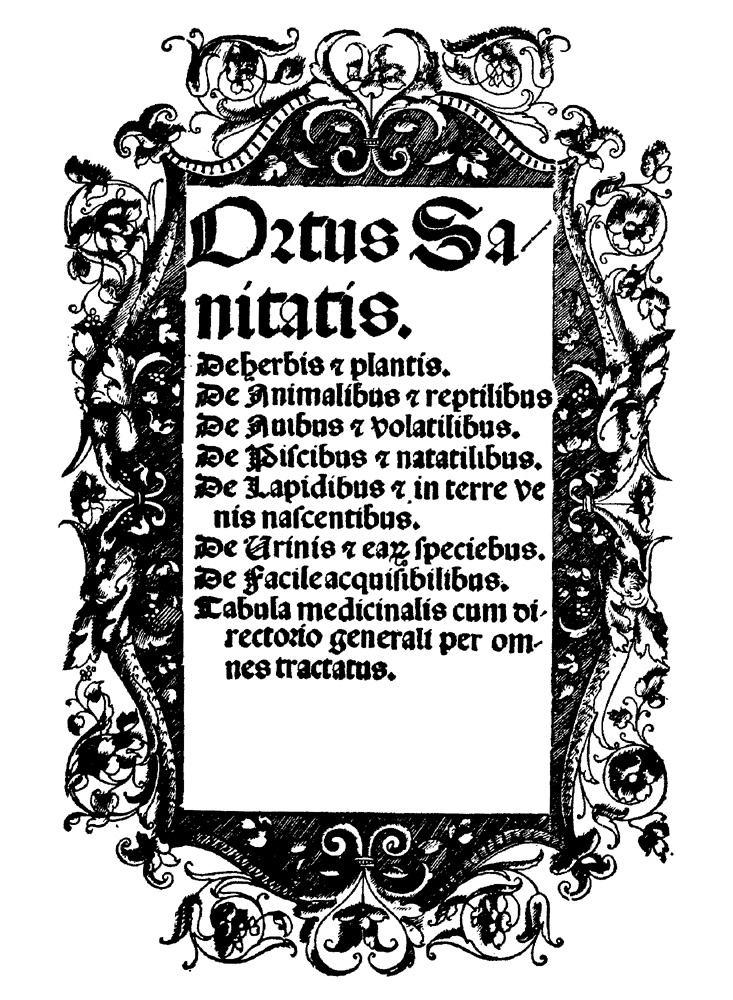
62. Latin, 1511.
[Hortus]
[Within a woodcut frame:] Ortus Sa- | nitatis. | De herbis & plantis. | De Animalibus & reptilibus | De auibus & volatilibus. | De Piscibus & natatilibus. | De Lapidibus & in terre ve | nis nascentibus. | De Urinis & ea[old aux] speciebus. | De Facile acquisibilibus. | Tabula medicinalis cum di- | rectorio generali per om- | nes tractatus.
2°: a8 b-k6 l8 m-r6 s8 t-z6 Aa6 Bb8 Cc-Ee6 Ff8 Gg-Ii6 A8 B-C6 D8 E-H6 I8 K-Q6 R8 S-T6 U8 aa-ff6 (ff6 blank); 368l.; no pagination or foliation. Title within a woodcut border, three full page woodcuts, and very many smaller cuts of plants, animals, genre pictures, etc. throughout. Colophon (ff5v): Impressum Venetijs per Bernardinum Benalium: Et | Joannem de Cereto de Tridino alias Tacuinum. | Anno Domini. M.cccccxi. Die. xi. augusti. | Regnante Inclyto Duce Leonardo Lau- | redano Venetiarum Principe.
Contents: a1r, Title.; a1v, Woodcut (Consultation of 6 physicians within a border).; a2r-Ii6v, De Herbis.; A1r, Sectional title page.; A1v, Woodcut (skeleton).; A2r-F6v, De Animalibus.; G4r-L5r, De Auibus.; L5v-P4v, De Piscibus.; P5r-V8v, De Lapidibus.; aa1r, Sectional title page.; aa1v, Woodcut (urine examine).; aa1r-bb4v, De Urinis.; bb5r-cc6v, Galenos' Liber de Facile Acquisibilibus.; dd1r-ff5v, Tabula Medicinalis.
Rare. Printed in Venice, by Bernardinus Benalius and Joannes Tacuinus de Cereto de Tridino in 1511. The first reprint of the Latin Hortus in Italy, valued for its fine woodcuts. The model for this reprint was according to Schreiber the Prüss edition of 1509, from which most of the cuts were copied. These cuts, being reveresed copies show many times considerable variations from those in the editions of 1497-1509. They were modified to be more attractive to the Italian purchaser of the book. Several of the cuts appear to be newly added.
Two of the full page woodcuts by a Venetian master appear here for the first time. Both are surrounded by an ornamental border, white on a black background. Essling says that the second of these is a free copy of a similar image found in Kentham Fasciculo de Medicina (1493). The image of the skeleton is a direct copy from the Prüss edition, as is indicated by the inclusion of some German names for the bones, eventhough this book was printed in Italy for the Italian market. After the tract on urine, there follows a short tract from Galen, "Liber de Facile Acquisibilibus," translated by Nicolaus de Regio.
The three full page woodcuts consist of: (1) consultation of six physicians, surrounded by a fine border, (2) human skeleton, (3) four physicians examine urine flasks, with three attendants, surrounded by a fine border.
Bibliographical references: Adams, Cambridge Books, 1967: H-1016. • Choulant, Graphische Incunabeln, 1858: p. 64, no. 18. • Essling, Livres à Figures Vénitiens, 1907-14: 3, 1723, p. 227 [two full page reproductions]. • Freilich Sale Catalog: no. 256. • Hunt Botanical Catalog: no. 12. • Klebs, Catalogue of Early Herbals, 1925: no. 49. • Mortimer Italian Books: no. 238 [NOT THIS EDITION FIX]. • Nissen (BBI): no. 2368. • NLM 16th Century Books (Durling): no. 2468. • NUC: 255, 431-4 [NH 0533385]. • Payne, `Herbarius' and `Hortus Sanitatis', 1901: p. 118. • Sander, Livre à Figures Italien, 1941: no. 3470. • Schreiber, Kräuterbücher, 1924: p. xxv.
63. Latin, 1517.
[Hortus]
[Within a wide, arched woodcut frame:] [In red:] Ortus | Sanitatis | [in black:] De [in red:] Herbis [in black:] et [in red:] Plantis. | [in black:] De [in red:] Animalibus [in black:] et [in red:] Reptilibus. | [in black:] De [in red:] Auibus [in black:] et [in red:] Uolatilibus. | [in black:] De [in red:] Piscibus [in black:] et [in red:] Natatilibus. | [in black:] De [in red:] Lapidibus [in black:] et in terre ve- | nis nascentibus. | De [in red:] Urinis [in black:] et [in red:] earum speciebus. | Tabula medicinalis | [in black:] cum [in red:] Directorio [in black:] ge | nerali per omnes | [in red:] tractatus. | [in black:] Anno. M.D.XVII.
2°: a8 b-k6 l8 m-r6 s8 t-z6 A6 B8 C-E6 F8 G-I6 K8 L-M6 N8 O-R6 S8 T-Z6 2A-2B6 2C8 2D-2E6 2F-2G8 2I-2K8; 356l.; no pagination or foliation. Two column. Ornamental initials. Capital spaces with guide letters and paragraph marks.
Contents: a1r, Title.; K1r, Four small woodcuts of animals, birds, fish and a man gathering stones.; K1v, Woodcut (skeleton).; K2r, De Animalibus.; Q4r, De Auibus.; U5v, De Piscibus.; Aa6r, De Lapidibus.; Gg1r, Small woodcut of a physician at a desk holding a flask, and a women with hamper standing before him.; Gg1v, De Urinis.; Ii1r, Tabula Medicinalis.
Very scarce. First edition of the Hortus produced by Renatus Beck, the successor of Prüss. Except for the skeleton cut, all the other full page woodcuts are omitted. The text cuts are the same as those used by Prüss, and are apparently imprinted from Prüss' woodblocks, some retouched, some are substituted by others.
Like the Prüss edition of 1499, after the section on plants there follows a leaf with four woodcuts with the headline, "Sequuntur alii tractatus" below. However, the cut of fishes is substituted by another, very similar one. At the start of the urine tract is a new small woodcut showing a physician, examining the urine flask presented him by a women. The fine title border was cut by Urs Graf, and shows naked children and vine.
Bibliographical references: Brunet: 3, 342. • Choulant, Graphische Incunabeln, 1858: p. 65, no. 19. • Cleveland Herbal & Botanical Collections, 1992: no. 29. • Hoover Collection: no. 433. • Hunt Botanical Catalog: no. 18. • Klebs, Catalogue of Early Herbals, 1925: no. 50. • Nissen (BBI): no. 2366. • NLM 16th Century Books (Durling): no. 2469. • NUC: 255, 431-4 [NH 0533388]. • Payne, `Herbarius' and `Hortus Sanitatis', 1901: p. 118. • Pritzel, Thesaurus Literaturæ Botanicæ, 1871-3: no. 10819. • Proctor, Index, 1898-1906: no. 10310.
64. Latin, 1536.
[Hortus]
Hortus sanitatis, quatuor libris haec quae snbsequuntur [!] complectens. De animalibus & reptilibus. De avibus & volatilibus. De piscibus & natatilibus. De gemmis & in vevis [!] terrae nascentibus ... Omnia castigatius, quam hactenus videre licuit ... Argentorati, Per Mathiam Apiarium, 1536.
2°: [5], 130l. Title within ornamental border; printer's mark on verso of leaf 130. Another issue omits the sentence "Singula autem capita ..." from the title. This edition does not contain book 1 "de Herbis," nor book 6 "de dispositione Urinae." Colophon: Argentorati in officina Mathiae Apiarij, mense martio. Anno M.D.XXXVI. Very scarce.
Bibliographical references: Choulant, Graphische Incunabeln, 1858: p. 65-6, no. 20. • NUC: 255, 431-4 [NH 0533392-5].
65. Latin, 1536.
[Hortus]
Ortus Sanitatis. De herbis: & plantis. De auibus & volatilibus ... De animalibus: & reptilibus. De piscibus & natatilibus. De lapidibus ... De vrinis ... De facile acquisibilibus. Habes praeterea his herbarum figuras aptissimas ... Que omnia nuper emendatiora in lucem prodeunt. Tabula ... [Uenetijs, Jmpressum per Bernardinum Benalium: Et Joannem de Cereto de Tridino alias Tacuninum] 1536.
2°: 368l Very scarce.
Bibliographical references: Essling, Livres à Figures Vénitiens, 1907-14: no. 1723. • Hunt Botanical Catalog: no. 12. • Mortimer Italian Books: no. 238. • Nissen (BBI): no. 2368. • NUC: 255, 431-4 [NH 0533397]. • Sander, Livre à Figures Italien, 1941: nos. 3470 & 3470n.
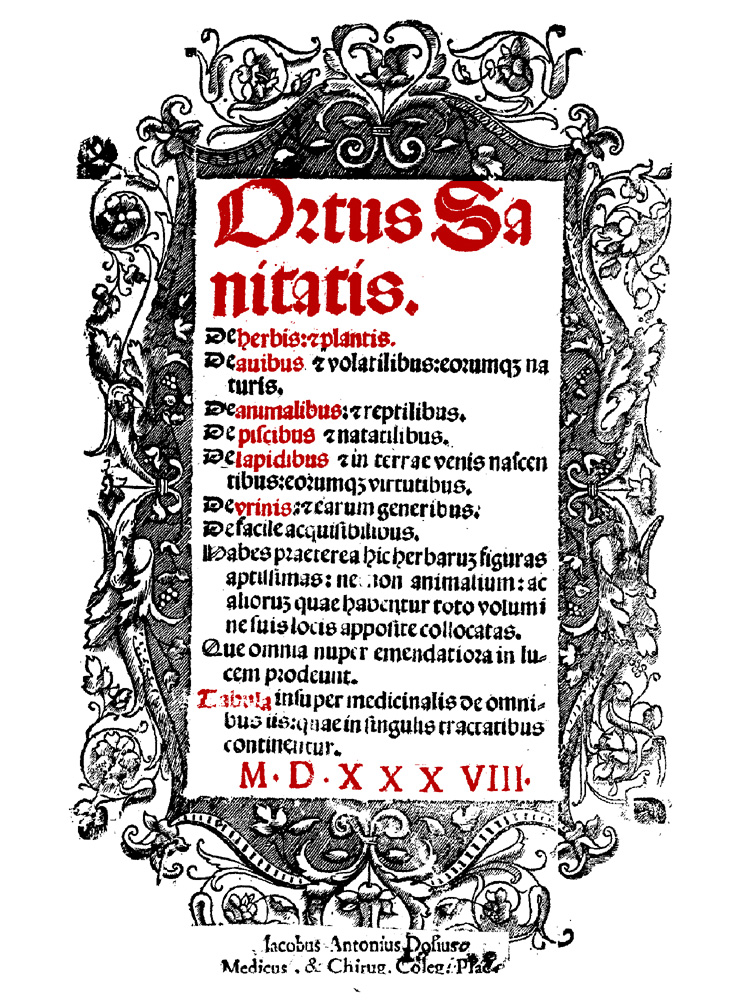
66. Latin, 1538.
[Hortus]
[Within an ornamental woodcut border:] [In red:] Ortus Sa | nitatis. | [in black:] De [in red:] herbis: & plantis. | [in black:] De [in red:] auibus [in black:] & volatillibus: eorumqz na | turis. | De [in red:] animalibus[in black:]: & reptilibus. | De [in red:] piscibus [in black:] & natatilibus. | De [in red:] lapidibus [in black:] & in terrae venis nascen | tibus: eorumqz virtutibus. | De [in red:] vrinis[in black:]: & earum generibus. | De facile acquifibilibus. | Habes praeterea hic herbaruz figuras | aptissimas: necnon animalium: ac | alioruz quae habentur toto volumi | ne suis locis apposite collocatas. | Que omnia nuper emendation in lu= | cem prodeunt. | [in red:] Tabula [in black:] insuper medicinalis de omni= | bus iis: quae in singulis tractatibus continentur. | [in red:] M. D. XXX VIII.
2°: a-z6 Aa-Ii6 A-C6 D-E8 F-T6 U8 aa-ff6 (ff6 blank); 354l.; no pagination or foliation. Gothic letter, with title in red and black within a woodcut border, three full page woodcuts (same as the 1511 edition), and very many text cuts of plants, animals, and genre pictures. Colophon (ff5v): Impressum Venetijs per Joannem de Cereto de T- | dino alias Tacuinum. Anno Dni. M.D.XXXVIII. | Pensis Aprilis. Regnante Incipto | Duce Andrea Srito Vene- | tiarum Principe. Page size: 302 x 210 mm.
Contents: a1r, Title page.; a1v, Full-page woodcut.; a2r, "Prohemium."; a2v-Ii6r, "Tractatus De Herbis."; Ii6v, Blank.; A1r, Sectional title page, "Tractatvs | De Anima | Libvs."; A1v, Full-page woodcut (Human skeleton).; A2r-G3v, Text of the Animalibus (animals).; G4r-L5v, Text of Avibus (birds).; L5v-P5v, Text of Piscibus (fish).; P6r-U8v, Text of Lapidibus (stones).; aa1r, Sectional title page, "Tractatvs | de Urinis. Et liber Salieni: | De facile acquisi= | bilibus. | [Cross]."; aa1v, Full-page woodcut.; aa2r-cc5v, Text of De Vrinis (urine).; cc5v-cc6r, "Tabula huius operis."; cc6v, Blank.; dd1r-ff5v, "Tabula super tractatu de Herbis. [- de Animalibus - de Piscibus - de Lapidibus].; ff5v, Colophon (on a slip of paper pasted to the page).; ff6, Blank.
Rare. Edition not noticed by most of the standard bibliographies. A parts title-issue reprint of the Venice, 1511 edition, with a new title page, printed in red and black and dated 1538, and with several other variations in the text. The sectional title page to the treatise on animals is printed in Roman letter, but in the 1511 edition is printed in black letter. The large woodcut on the urines is partly changed and reduced. Some quires are taken from the 1511 edition, the printer apparently still being in possession of a part of the older 1511 edition. This is shown on the last printed leaf where a slip of paper with the 1538 colophon is pasted over the original 1511 colophon.
Bibliographical references: Klebs, Catalogue of Early Herbals, 1925: no. 51. • Nissen (BBI): no. 2369. • NUC: 255, 431-4 [NH 0533399].
French editions
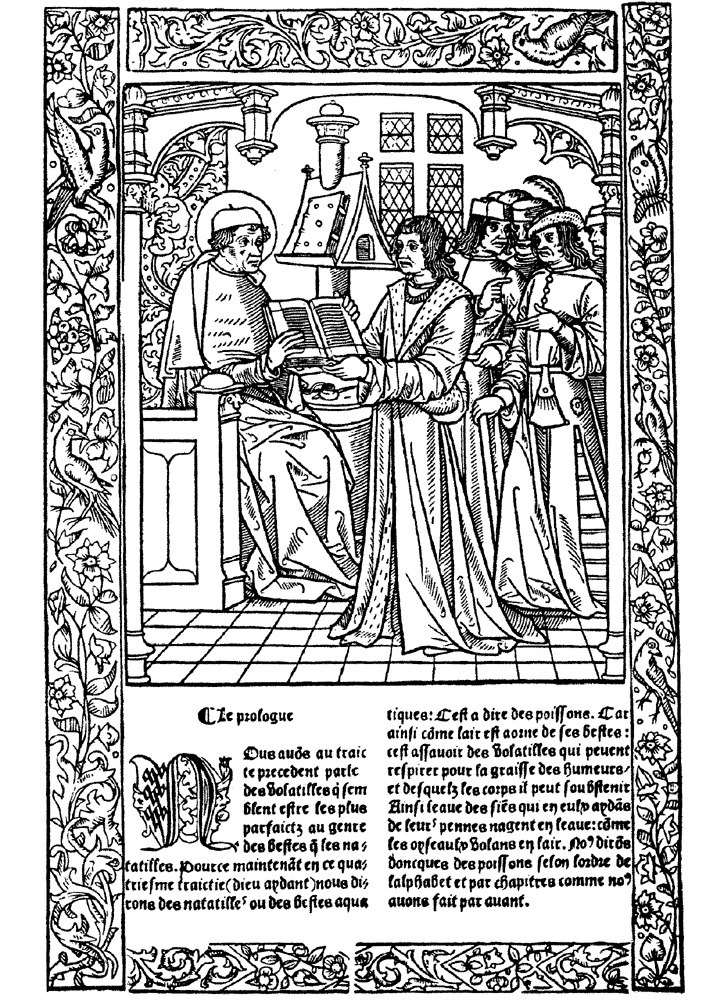
67. French, c1500 [French transl.].
[Hortus]
Ortvs sanitatis | translate de Latin | en Francois.
2 vols. [Vol 1] 2°: CLXXV (i.e., 275), [16]l.; [Vol 2] 2°: CLXX, [14]l. Bâtarde type. Two columns, 49-50 lines. Five full-page woodcuts (on versos of each volume title, leaf K5, and the section title of the final treatise on urine, one repeated), 540 half-page column-wide woodcuts of plants, animals, and precious stones. 3 woodcut titles in grotesque calligraphic style, numerous calligraphic woodcut initials with grotesque human faces throughout. Woodcut printer's device on the last leaf.
Very rare. First French edition and the only complete translation of the Hortus Sanitatis, printed in Paris by Anthoine Vérard [see note below]. It is a magnificent monument of early French typography, and one of the finest of the Hortus editions, of which only a few examples are known. The first volume describes the herbs, the second beasts, fishes, and stones, and includes the tract on urine. At the end are extensive indexes.
The fine large woodcuts represent: (1, verso of title leaf and repeated on leaf R1v of the second volume) an ecclesiastical person seated in a chair, with several other figures, one of them presenting a book, (2, leaf K5v) an author presenting his book to King Charles VIII on horseback with other persons engaged in flying hawks, (3, leaf aaa1v) apohtecary's shop, (4, leaf A1v) human skeleton. The full page cuts 3 and 4 appear to be copied from the original Grüninger cuts, although the text illustrations appear to be derived from the second Latin edition of the Hortus (assigned to Strassburg, Prüss, not after 21 October 1497).
Anthoine Vérard. (Born: ; Died: Paris, France, 1513) French illuminator, wood engraver, printer & bookseller. Vérard flourished in Paris from about 1485 to 1512. Scarcely anything is known of his life, other than his shop occupied a series of buildings in Paris, and that he illustrated and published a series of works. He is thought to have illuminated a Danse Macabre printed on vellum, of which only two copies exist.
Bibliographical references: BNIC: H-297. • Brunet: 3, 342 [wrong collation]. • Choulant, Graphische Incunabeln, 1858: p. 73, no. 37 [not seen]. • Claudin, Histoire de l'Imprimerie, 1900-15: 1, 191 or 2, 504. • Fairfax Murray (French): 1, no. 227. • Goff: H-490. • Hain, Repertorium Bibliographicum, 1826-38: HC 8958 [wrong collation]. • IGI: no. 4903. • Klebs, Incunabula Scientifica, 1938: no. 509.5. • Klebs, Herbals of the Fifteenth Century, 1917-8: p. 51, no. 5 [476 leaves]. • Klebs, Catalogue of Early Herbals, 1925: no. 52. • Macfarlane, Anthoine Vérard,: no. 140. • Nissen (BBI): no. 2373. • NUC: 255, 431-4 [NH 0533402]. • Payne, `Herbarius' and `Hortus Sanitatis', 1901: pp. 119-22. • Pellechet, Catalogue General des Incunables, 1970: no. 5755. • Polain, Catalogue, 1932: no. 2004 (& supplement) [about 1503?]. • Pritzel, Thesaurus Literaturæ Botanicæ, 1871-3: no. 10835. (Vérard) Bryan's Dictionary of Painters, 1903-4: 5, 280. • Biographie Universelle: 43, 132-3. • Nouvelle Biographie Générale (Hoefer): 45, cols. 1093-5.
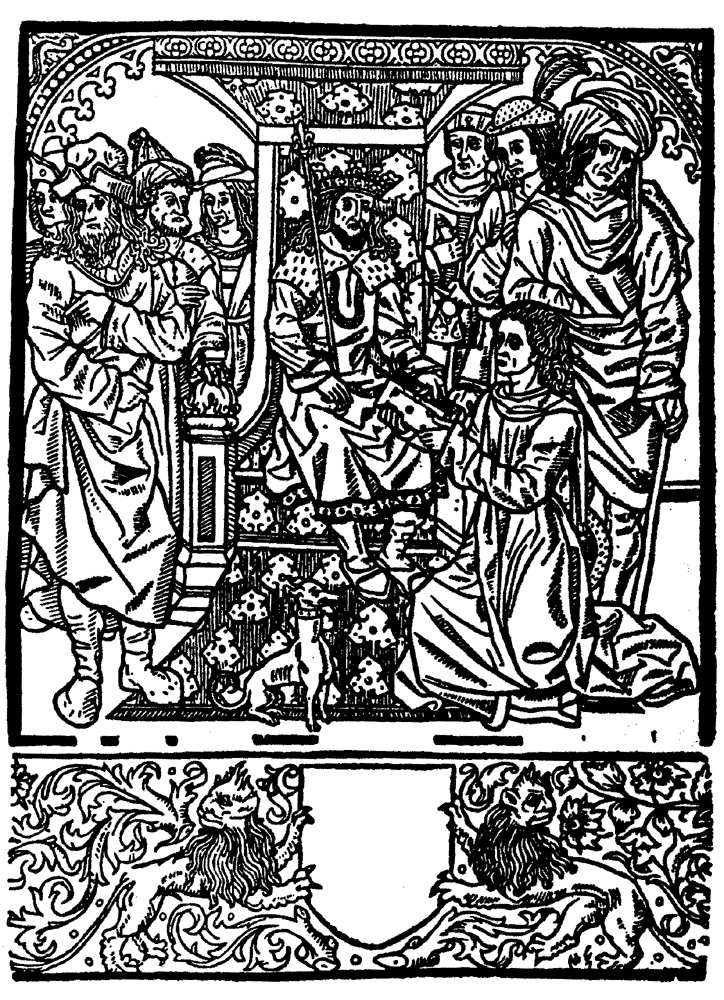
68. French, 1529 [French transl.].
[Hortus]
Hortus sanitatis, translate de latin en francois. Paris, 1529.
Two parts in one volume. [Part 1] 2°: 246, 12l.; [Part 2] 2°: 149, 20 leaves (the last blank). Two columns, Gothic letter, 54 lines. Title printed in red and black, with a fine woodcut (repeated on the title to the second part), large woodcut on the verso of the title leaf, two other large woodcuts (1: human skeleton; 2: apothecary's shop), over 1,000 smaller text woodcuts of plants, animals, birds, precious stones, etc. Woodcut initials. Pritnter's device (large initial with head and bird).
Very rare. Second edition of the French translation of the Hortus Sanitatis. It contains nearly the same illustrations as the Vérard edition. The text cuts reappear with few exceptions, printed from the old blocks, also the skeleton and the apothecary's shop, borrowed by Vérnard from Strassburg. There are also some newly added cuts not copied from any German herbal, but probably derived from some work on chivalry. (Klebs/Becher)
Bibliographical references: Brunet: 3, 342 & Suppl. I, 657. • Klebs, Catalogue of Early Herbals, 1925: no. 53. • NUC: 255, 431-4 [NH 0533403]. • Pritzel, Thesaurus Literaturæ Botanicæ, 1871-3: no. 10836.
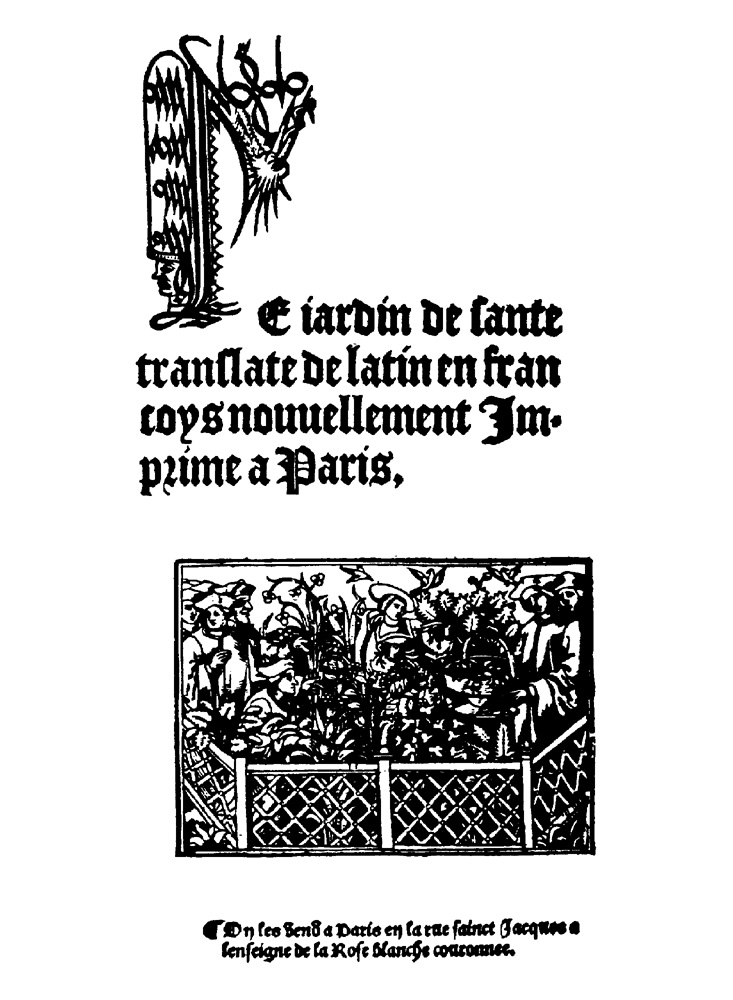
69. French, 1539 [French transl.].
[Hortus]
Le iardin de sante | translate de latin en fran | coys nouvellement Im= | prime a Paris | [Woodcut] | [Dark C] On les vend a Paris en la rue sainct Jacques | a lenseigne de la Rose Blanche couronnee.
Le traicte des bestes, | oyseaulx, poissons, pier | res precieuses, et urines | du jardin de sante.
2 parts in one volume. A8 B-X6 y6 AA-SS6 TT4 \ a6 \ e6 a-ff6 gg8; 428l.; Part 2 has a separate title page. Imprint from colophon. Printer's device on leaf Tt4 and at the end. Some illustrations repeated in different chapters. Picture on recto of b1 printed upside-down. Includes indexes. Page size: 308 x 204 mm.
Very scarce. A reprint of the second edition of 1529. It is printed in two volumes, which are usually found bound together. It is inferior in typography to the Vérard's editon of 1500, but has nearly the same illustrations.
Apparently 3rd French ed.; cf. C.W. Traylen, Catalog 93, no. 385. Mentioned by Klebs/Becher (no. 53).
Bibliographical references: Choulant, Graphische Incunabeln, 1858: p. 73, no. 38 [not seen]. • Mortimer French Books: no. 321. • NUC: 255, 431-4 [NH 0533405]. • Payne, `Herbarius' and `Hortus Sanitatis', 1901: pp. 122-4.
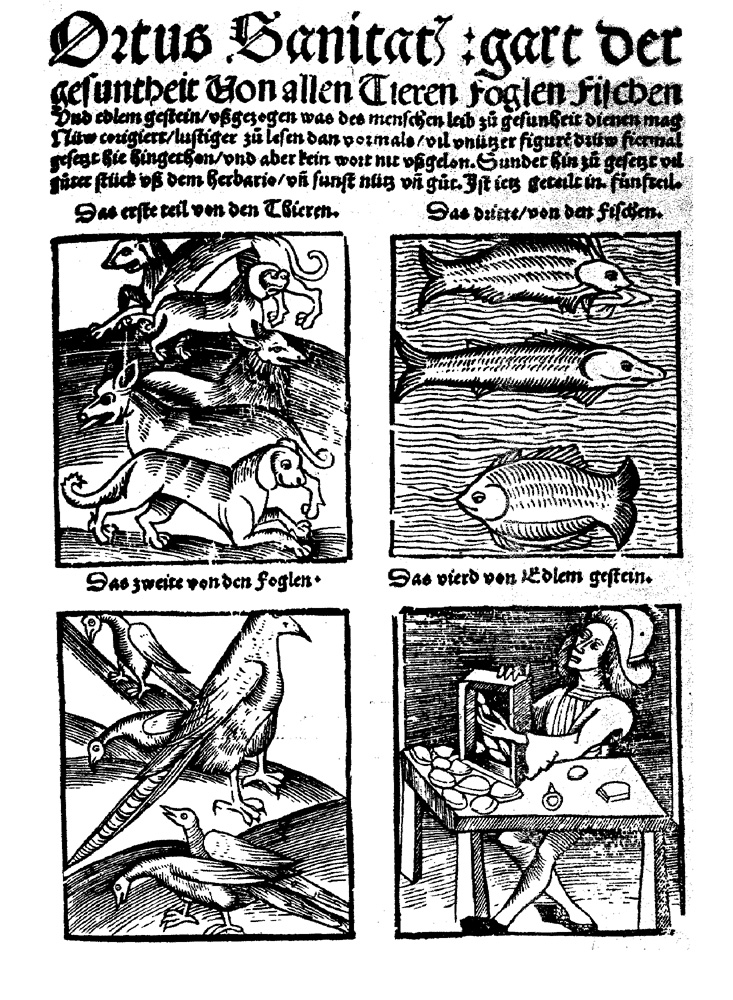
70. German, 1529.
[Hortus]
Ortus Sanitats: gart der | gesundheit von allen Tieren foglen ficschen | Vnd edlem gestein/ vszgezogen was des menschen leib zů gesunheit dienen mag | Nüw corigiert/ lustiger zů lesen dan vormals/ vil vnützer figuren drüw fiermal | gesetzt hie hingethon, vnd aber kein wort nit vszgelon. Sundet hin zů gesetzt vil | guter stück vsz dem herbario/ vn sunst nütz vn gut. Jst jetz geteilt in fünfteil. | [Four small woodcuts depiciting animals, fish, birds and stones arranged in a square, with each cut having a description above].
2°: [6], [2], 135l. Two columns, Gothic type.
Rare. Printed in Strasbourg by Johannes Grienynger on the 17 March 1529.
Bibliographical references: Choulant, Graphische Incunabeln, 1858: p. 69, no. 26. • Nissen (BBI): no. 2372.
.